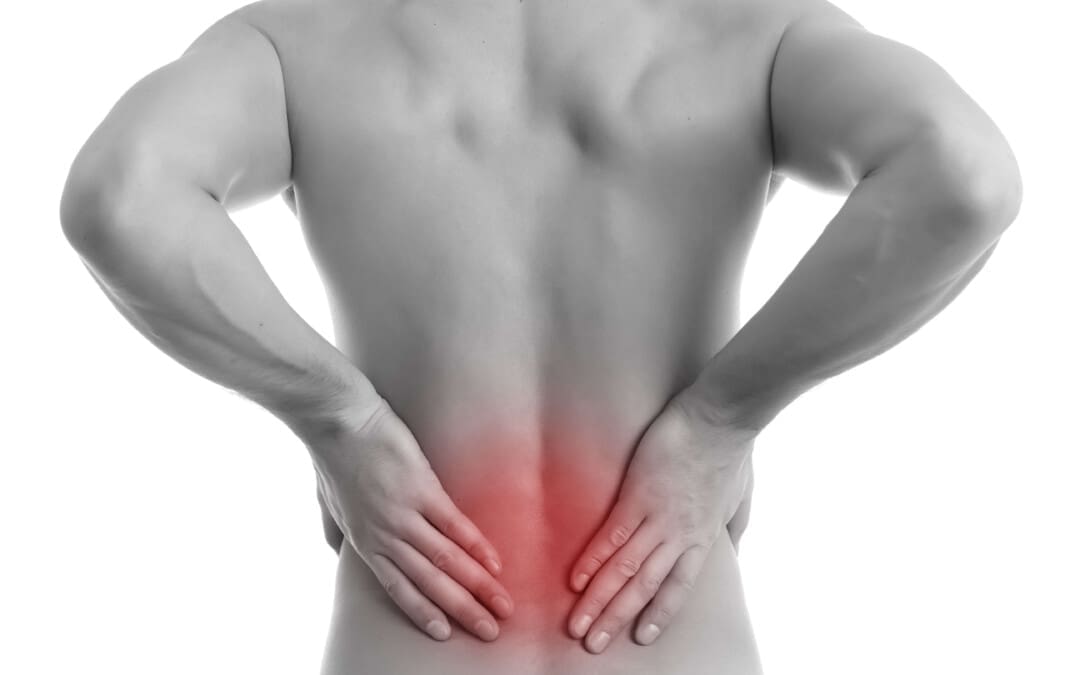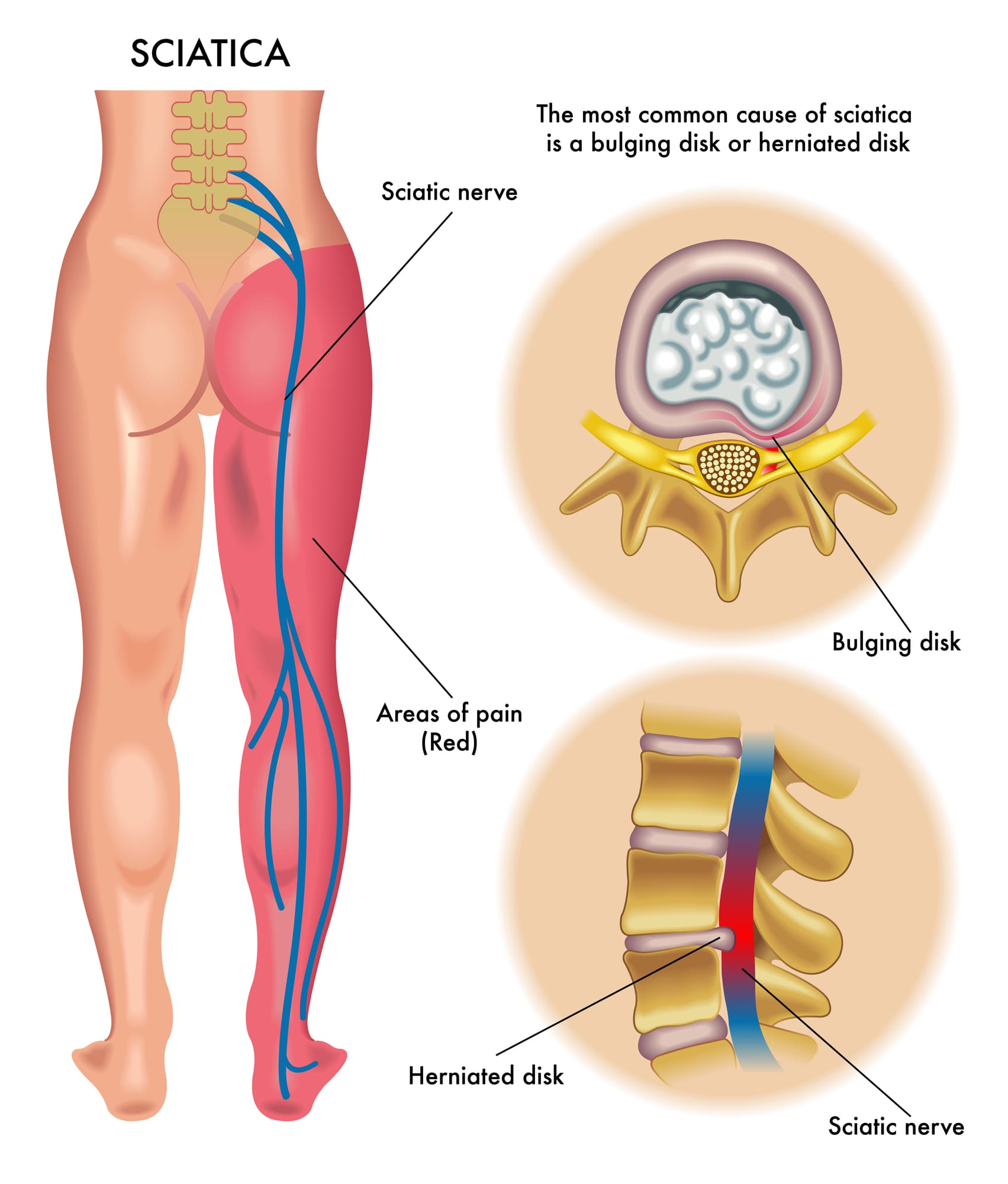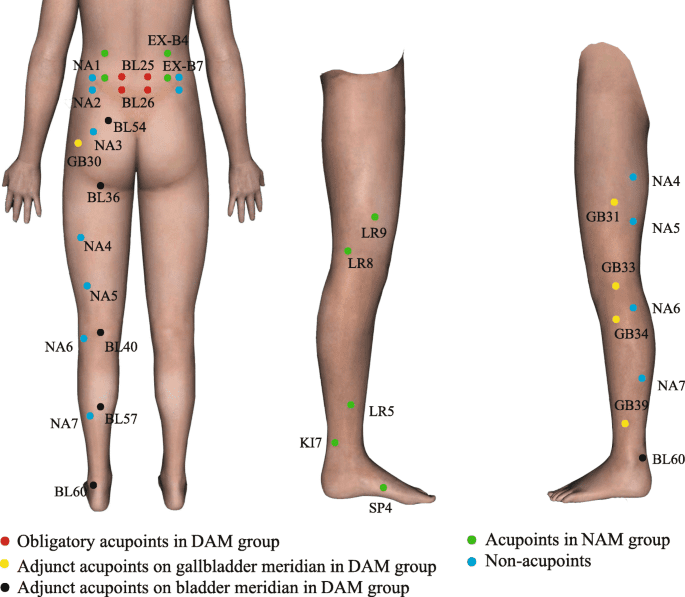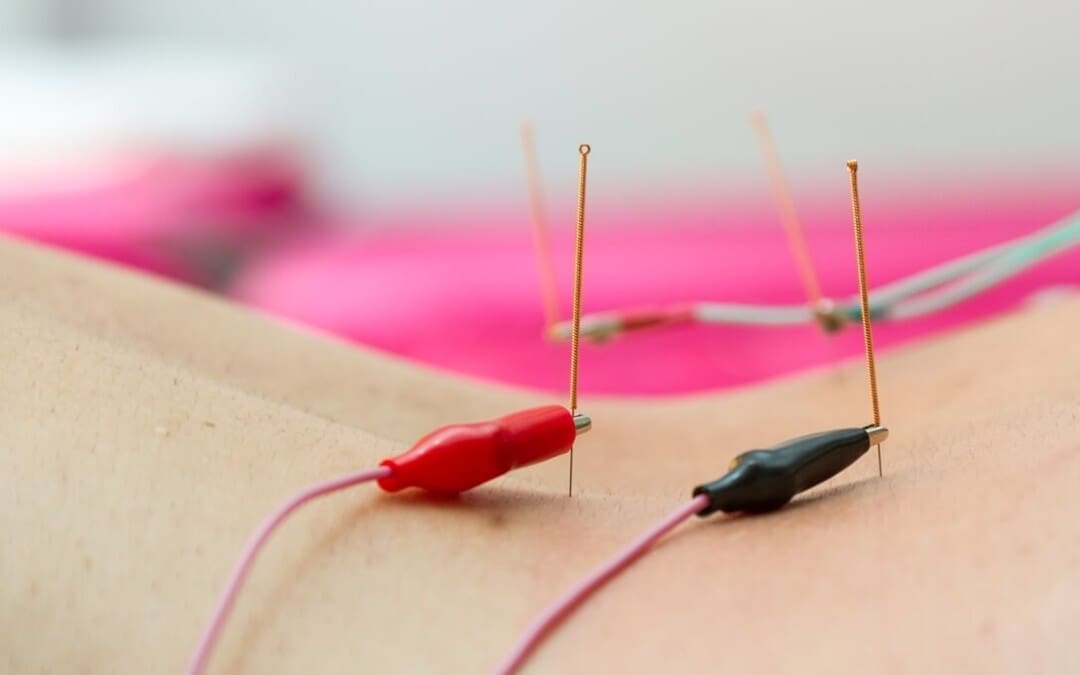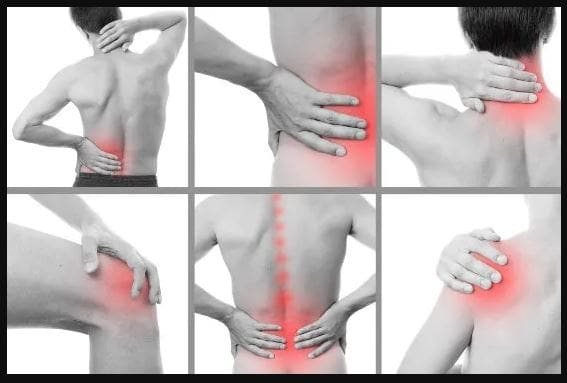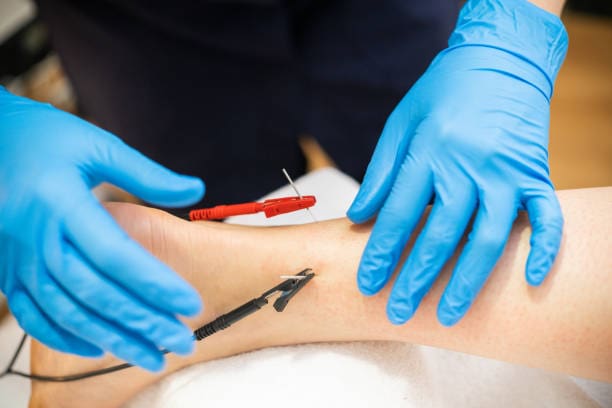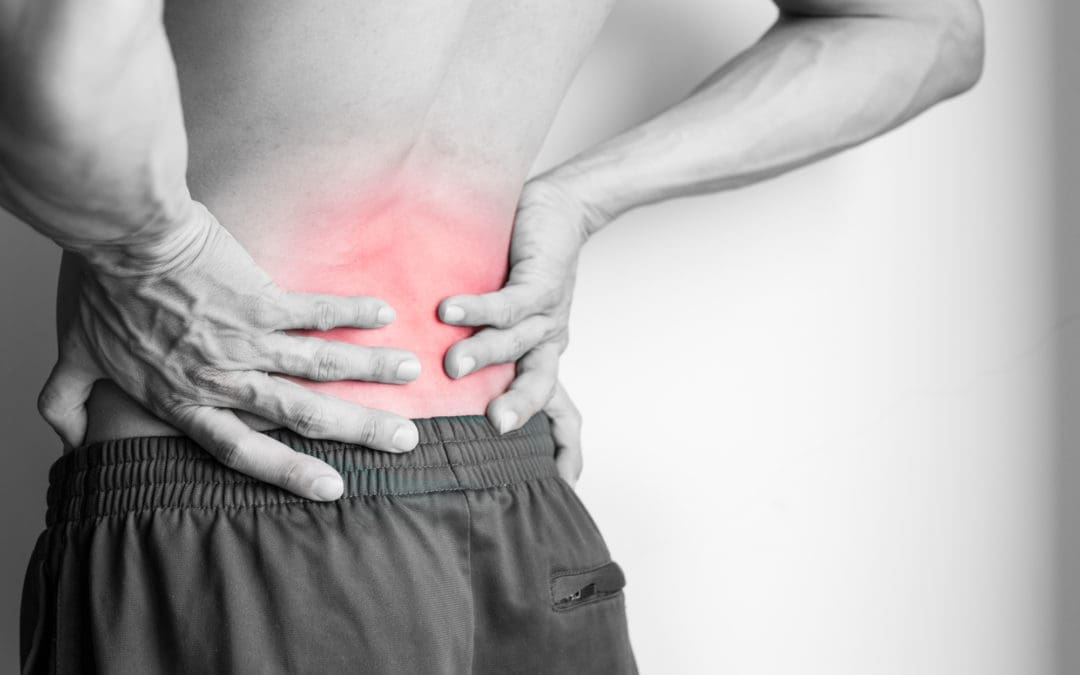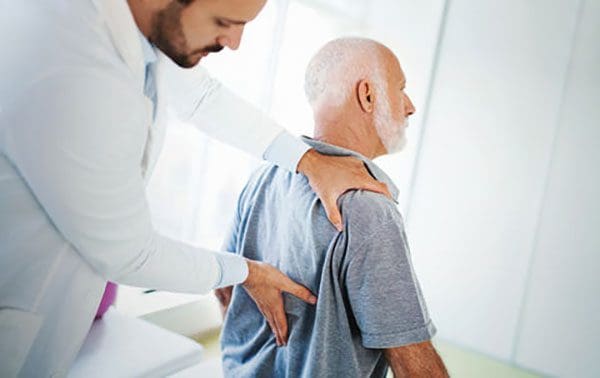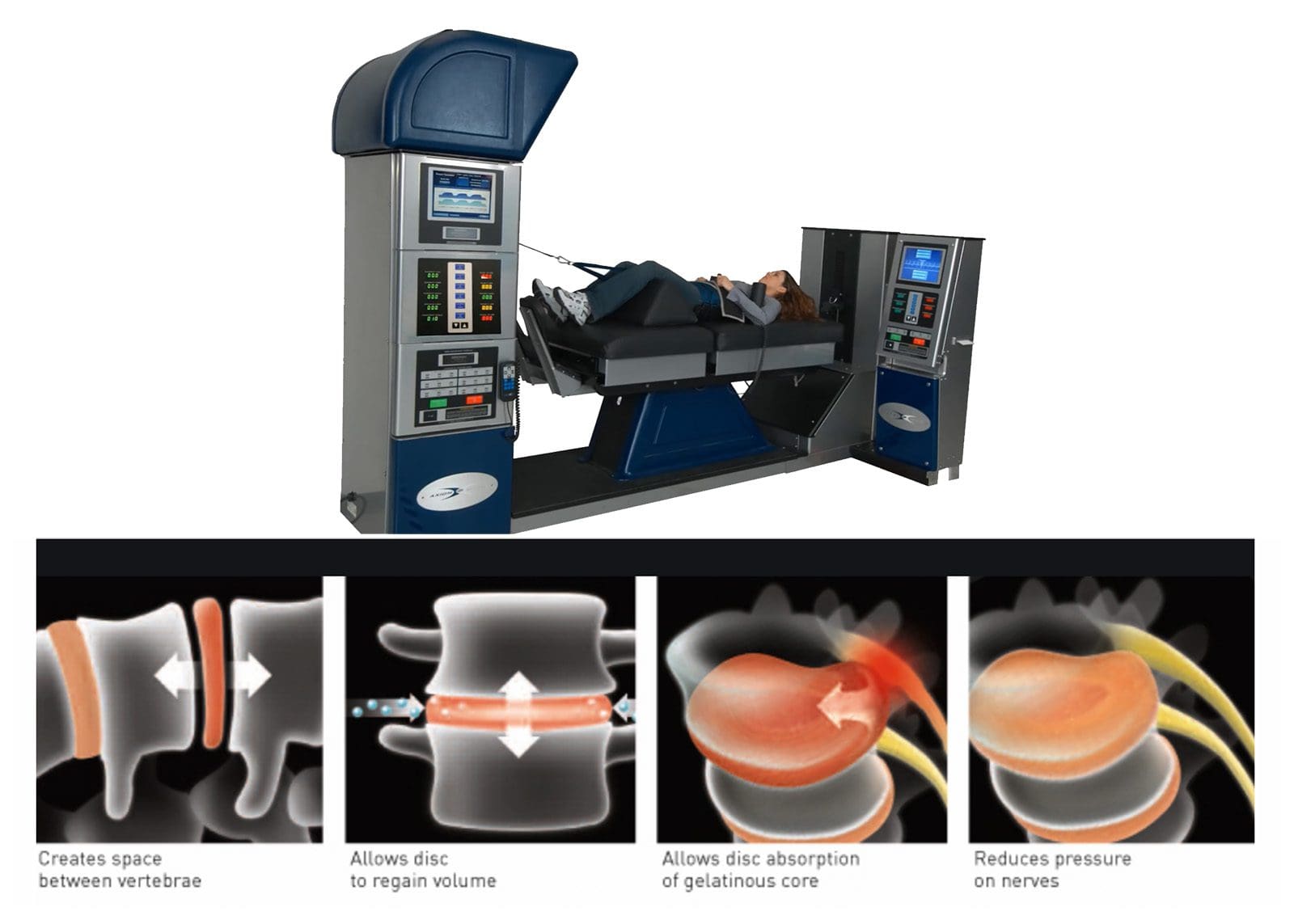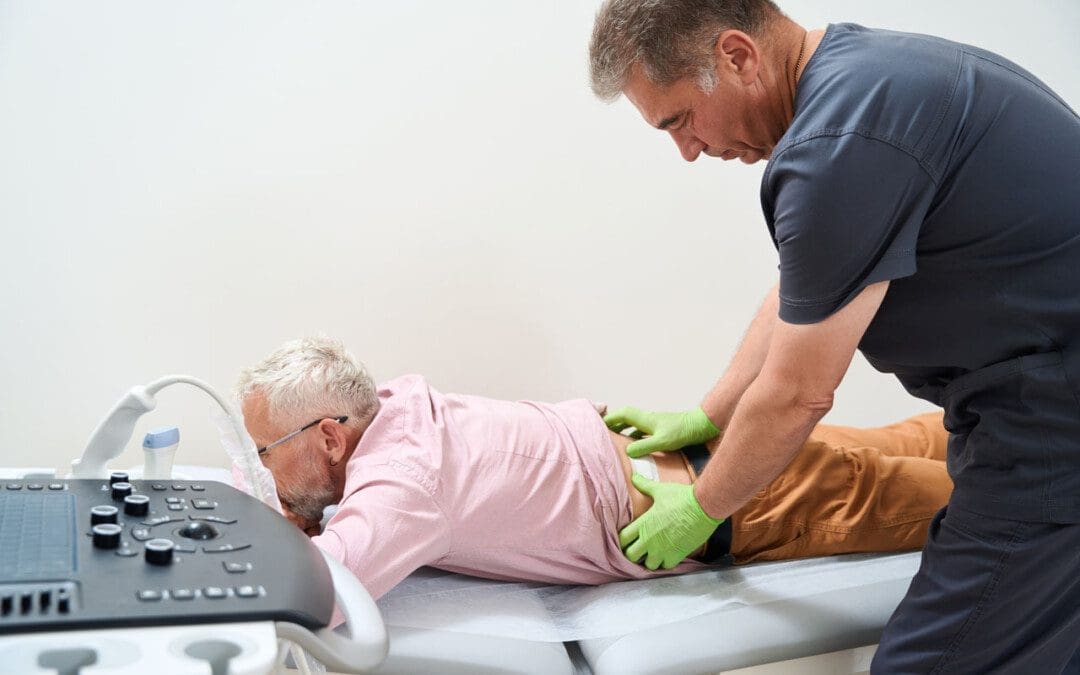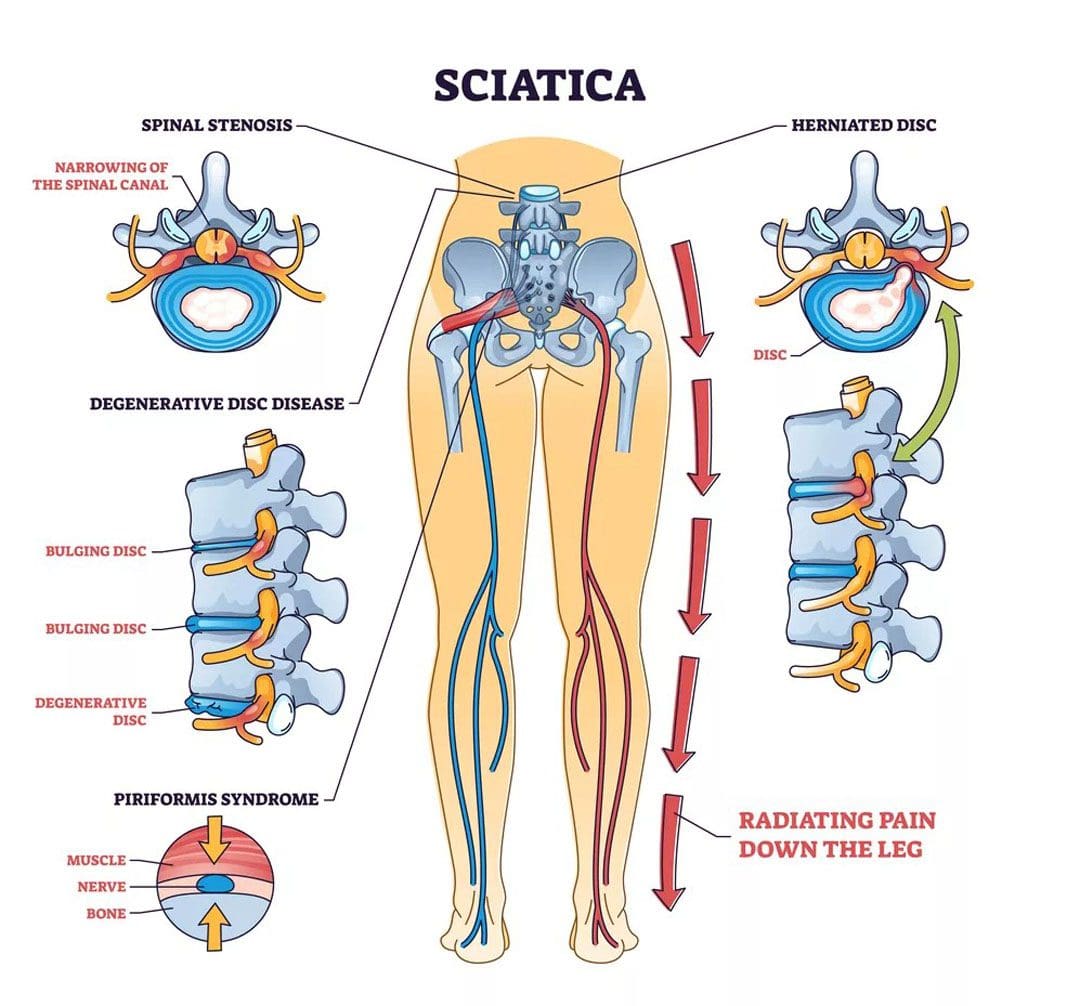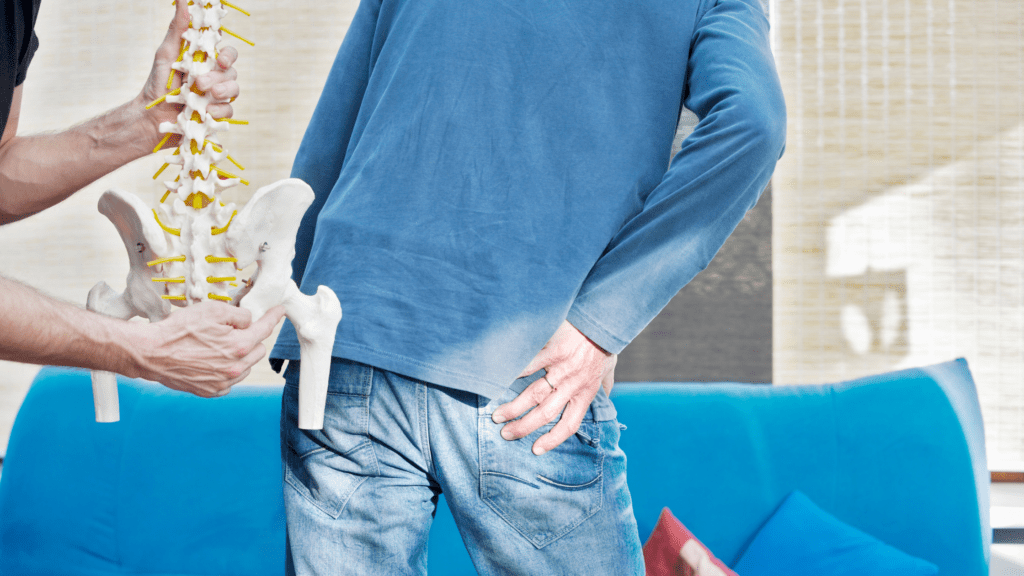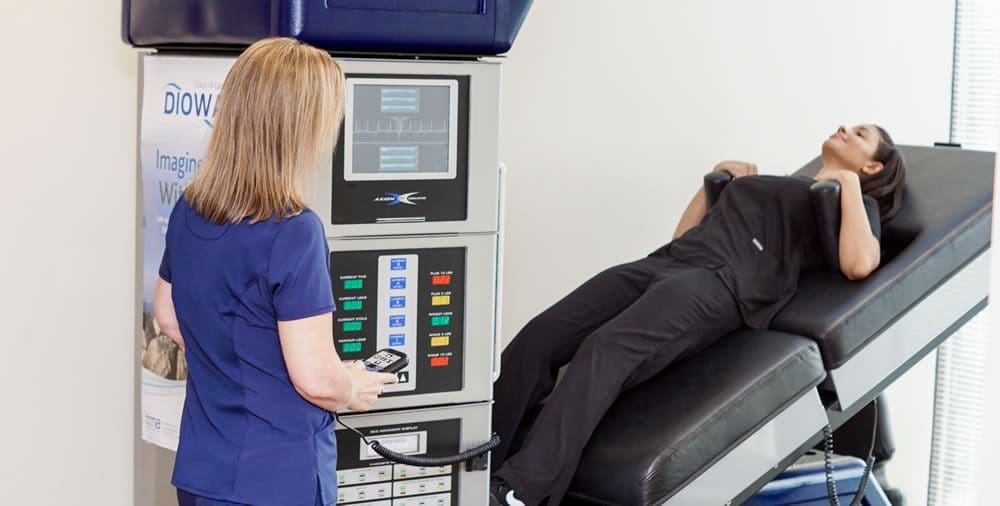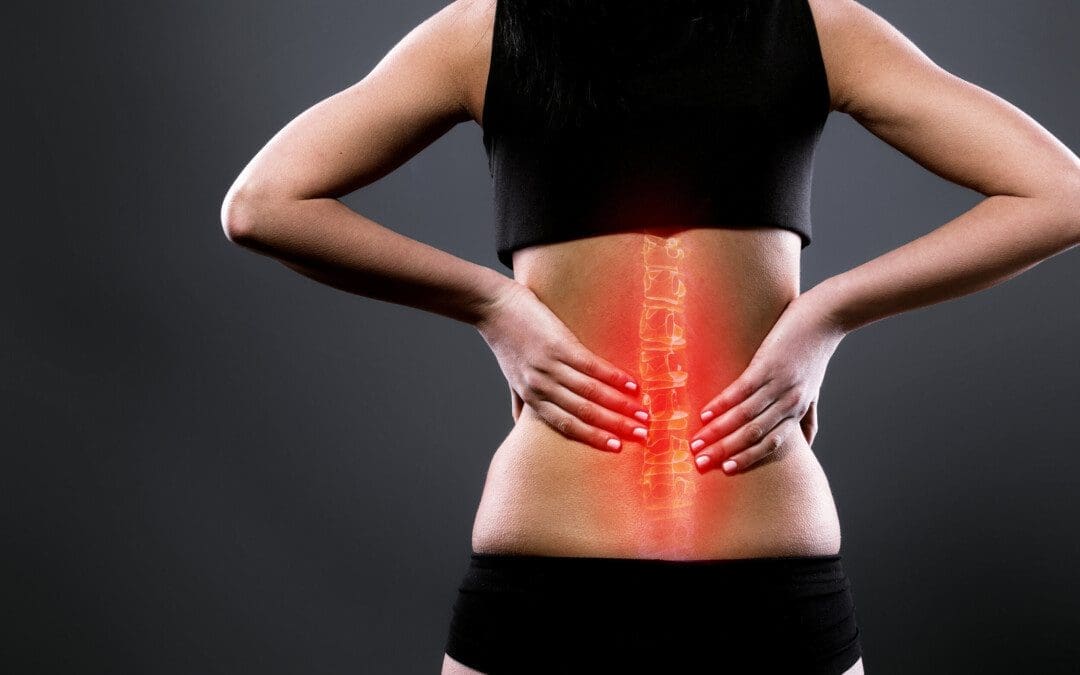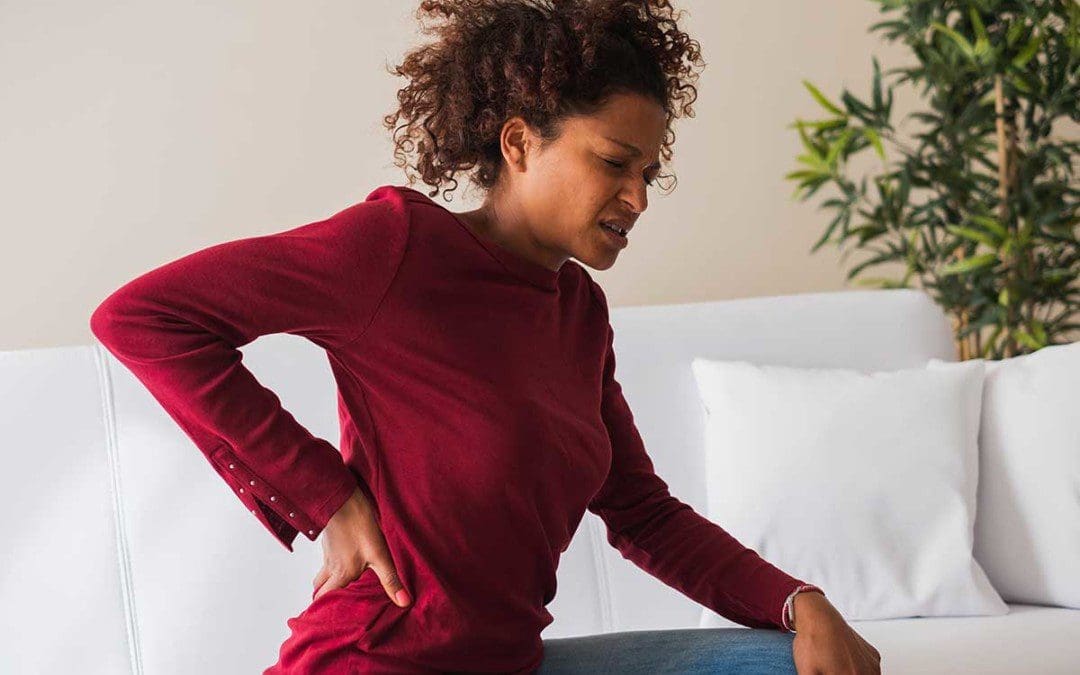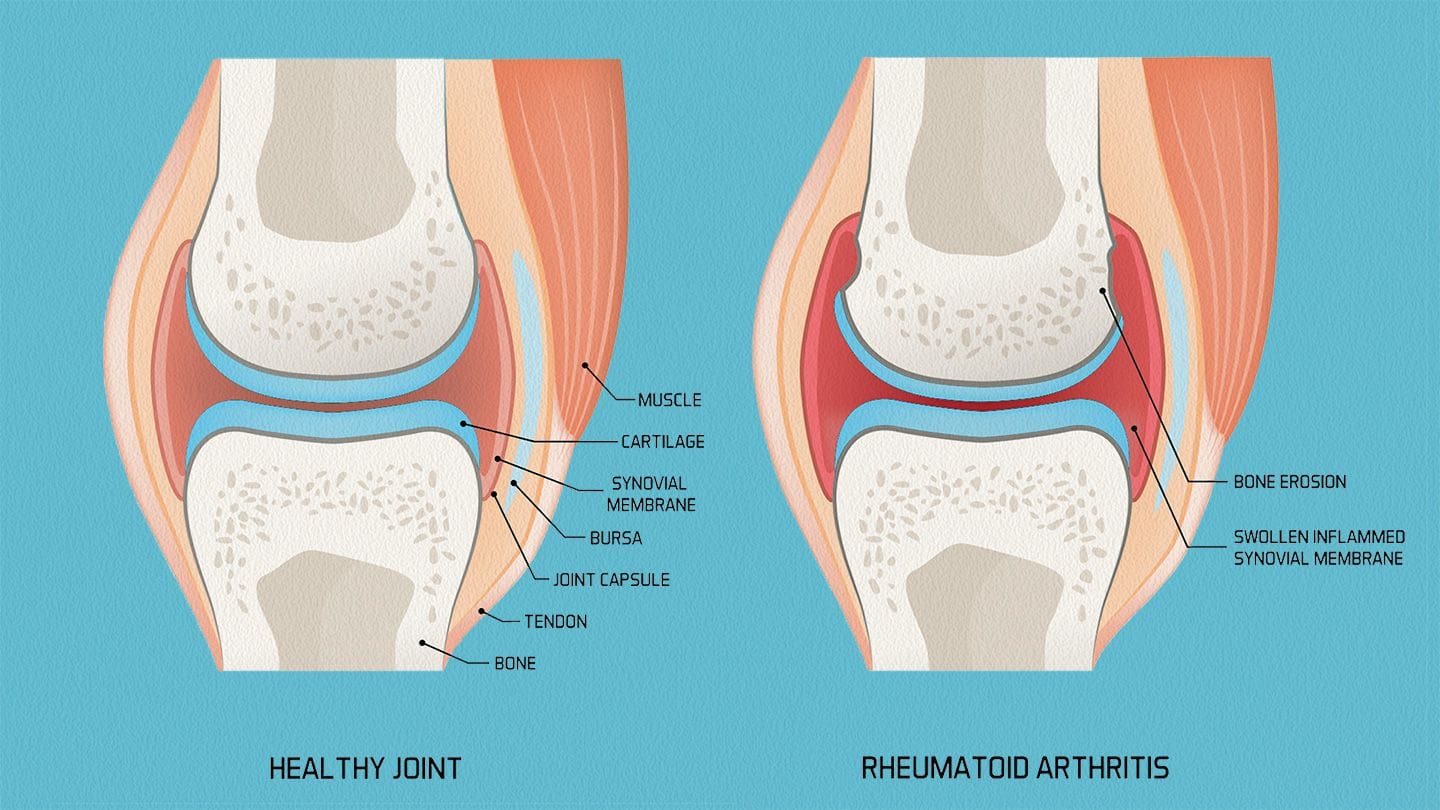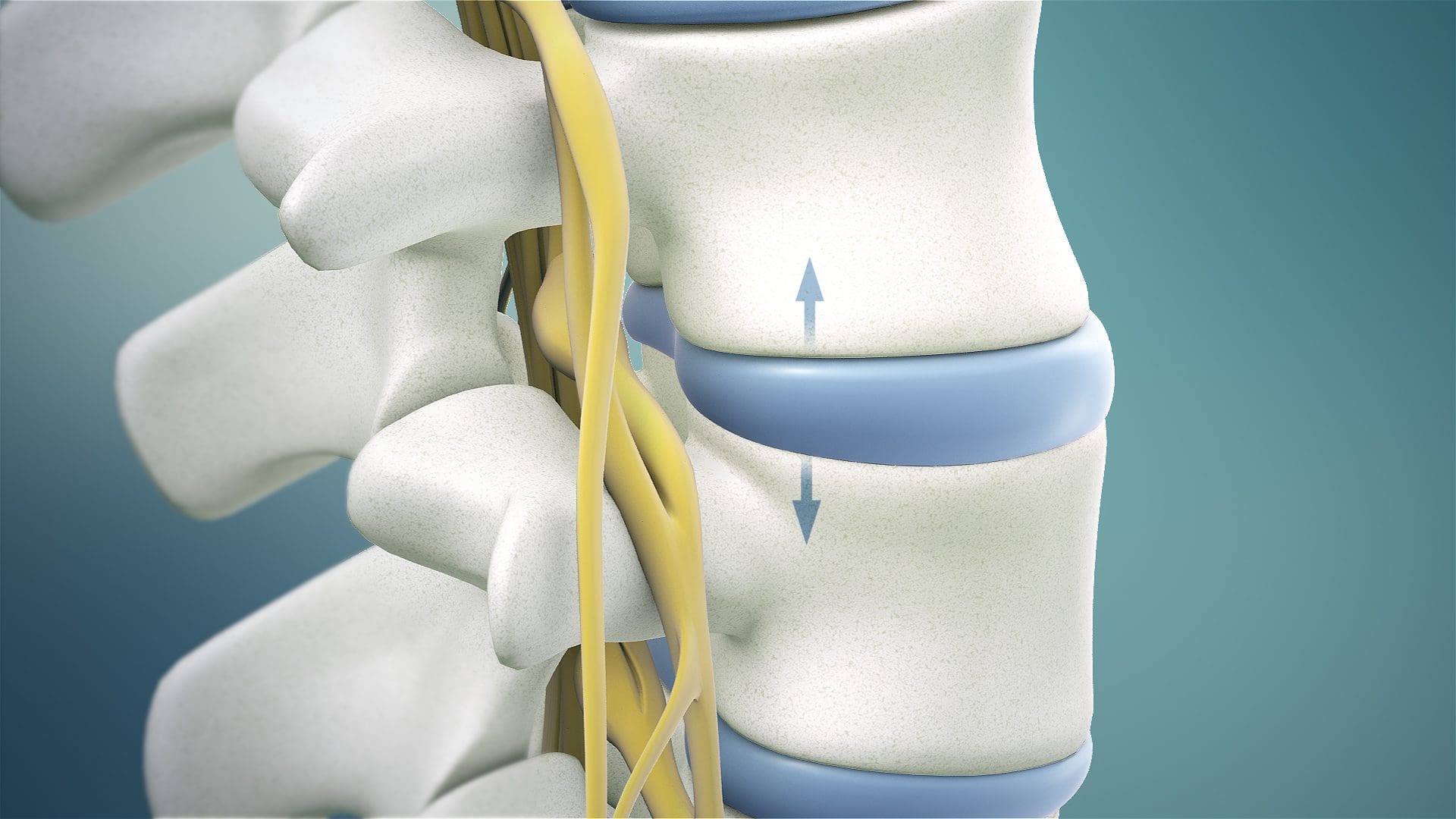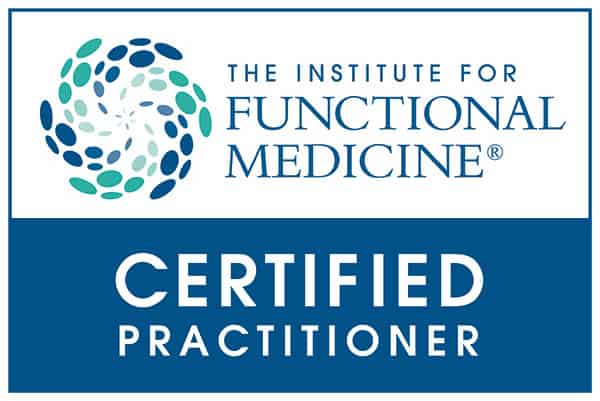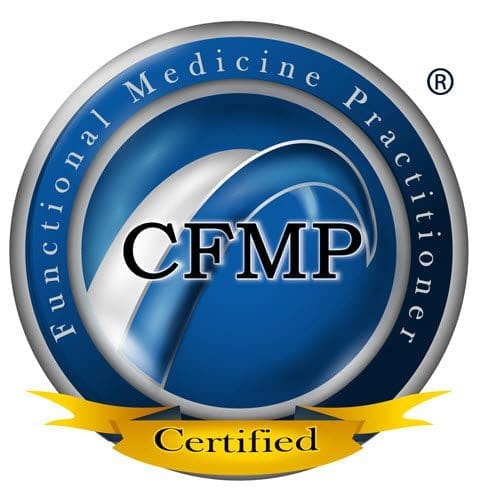ការឈឺទ្រូងរ៉ាំរ៉ៃ
Back Clinic ក្រុមឈឺខ្នងរ៉ាំរ៉ៃ។ ការឈឺឆ្អឹងខ្នងរ៉ាំរ៉ៃមានឥទ្ធិពលយ៉ាងខ្លាំងទៅលើដំណើរការសរីរវិទ្យាជាច្រើន។ វេជ្ជបណ្ឌិត Jimenez បង្ហាញពីប្រធានបទ និងបញ្ហាដែលប៉ះពាល់ដល់អ្នកជំងឺរបស់គាត់។ ការយល់ដឹងអំពីការឈឺចាប់គឺមានសារៈសំខាន់ចំពោះការព្យាបាលរបស់វា។ ដូច្នេះនៅទីនេះ យើងចាប់ផ្តើមដំណើរការសម្រាប់អ្នកជំងឺរបស់យើងក្នុងដំណើរនៃការជាសះស្បើយឡើងវិញ។
មនុស្សគ្រប់គ្នាមានអារម្មណ៍ឈឺចាប់ពីមួយពេលទៅមួយពេល។ នៅពេលដែលអ្នកកាត់ម្រាមដៃរបស់អ្នកឬទាញសាច់ដុំ, ការឈឺចាប់គឺជាវិធីរបស់រាងកាយអ្នកដើម្បីប្រាប់អ្នកថាអ្វីមួយខុស។ នៅពេលរបួសឱ្យជាសះស្បើយអ្នកឈប់ឈឺចាប់។
ការឈឺចាប់រ៉ាំរ៉ៃខុសគ្នា។ រាងកាយរបស់អ្នកធ្វើឱ្យខូចសប្តាហ៍រាប់ខែឬច្រើនឆ្នាំបន្ទាប់ពីការរងរបួស។ វេជ្ជបណ្ឌិតជារឿយៗកំណត់ពីការឈឺចាប់រ៉ាំរ៉ៃដូចជាការឈឺចាប់ដែលមានរយៈពេលពី 3 ទៅ 6 ខែឬច្រើនជាងនេះ។
ការឈឺឆ្អឹងខ្នងរ៉ាំរ៉ៃអាចមានឥទ្ធិពលពិតប្រាកដលើជីវិតប្រចាំថ្ងៃរបស់អ្នក និងសុខភាពផ្លូវចិត្តរបស់អ្នក។ ប៉ុន្តែអ្នក និងគ្រូពេទ្យរបស់អ្នកអាចធ្វើការរួមគ្នាដើម្បីព្យាបាលវាបាន។
សូមអំពាវនាវឱ្យយើងជួយអ្នក។ យើងយល់ពីបញ្ហាដែលមិនគួរត្រូវបានគេស្រាល។
by វេជ្ជបណ្ឌិត Alex Jimenez ឈឺខ្នង , ការឈឺទ្រូងរ៉ាំរ៉ៃ , ការឈឺចាប់រ៉ាំរ៉ៃ , ការព្យាបាលដោយប្រើអេឡិចត្រុង , Sciatica , រោគឈឺចាប់នៅសរីរាង្គ , ការព្យាបាល , ការឆ្លុះបញ្ចាំង Viscerosomatic
តើផលប៉ះពាល់នៃ electroacupuncture អាចកាត់បន្ថយ sciatica ចំពោះបុគ្គលដែលមានការឈឺឆ្អឹងខ្នងទាបដើម្បីស្តារការចល័តរបស់ពួកគេបានទេ?
សេចក្តីផ្តើម
នៅពេលដែលមនុស្សជាច្រើនចាប់ផ្តើមប្រើសាច់ដុំរបស់ពួកគេច្រើនពេកនៅក្នុងផ្នែកខាងក្រោម វាអាចនាំឱ្យមានបញ្ហាជាច្រើនដែលបណ្តាលឱ្យមានការឈឺចាប់ និងមិនស្រួល។ បញ្ហាការឈឺចាប់ទូទៅបំផុតមួយនៅក្នុង quadrants ខាងក្រោមនៃប្រព័ន្ធ musculoskeletal គឺ sciatica ដែលត្រូវបានផ្សារភ្ជាប់ជាមួយនឹងការឈឺខ្នងទាប។ ការឈឺចាប់ទាំងពីរនេះអាចប៉ះពាល់ដល់ទម្លាប់ប្រចាំថ្ងៃរបស់មនុស្សម្នាក់ ហើយនាំឱ្យពួកគេឈឺចាប់ និងមិនស្រួល។ ស្ថានភាពសាច់ដុំនេះគឺជារឿងធម្មតា ហើយនៅពេលវាប៉ះពាល់ដល់ជើងម្ខាង និងខ្នងផ្នែកខាងក្រោម មនុស្សជាច្រើនបញ្ជាក់ថា វាជាការឈឺចាប់ដោយបាញ់កាំជ្រួចដែលមិនបាត់មួយរយៈ។ ជាសំណាងល្អ មានការព្យាបាលដូចជា electroacupuncture ដើម្បីកាត់បន្ថយ sciatica ដែលទាក់ទងនឹងការឈឺខ្នងទាប។ អត្ថបទថ្ងៃនេះមើលទៅលើការតភ្ជាប់ sciatica-low-back របៀបដែល electroacupuncture កាត់បន្ថយការភ្ជាប់ការឈឺចាប់នេះ និងរបៀបដែល electroacupuncture អាចស្តារភាពចល័តដល់បុគ្គល។ យើងនិយាយជាមួយអ្នកផ្តល់សេវាវេជ្ជសាស្រ្តដែលមានការបញ្ជាក់ដែលបង្រួបបង្រួមព័ត៌មានអ្នកជំងឺរបស់យើងដើម្បីវាយតម្លៃពីរបៀបកាត់បន្ថយការភ្ជាប់ sciatica-low-back ជាមួយនឹង electroacupuncture ។ យើងក៏ជូនដំណឹង និងណែនាំអ្នកជំងឺអំពីរបៀបដែលការព្យាបាលដោយប្រើអេឡិចត្រិចអាចត្រូវបានផ្សំជាមួយការព្យាបាលផ្សេងទៀត ដើម្បីស្តារភាពចល័តដល់រាងកាយ។ យើងលើកទឹកចិត្តអ្នកជំងឺរបស់យើងឱ្យសួរអ្នកផ្តល់សេវាវេជ្ជសាស្រ្តដែលពាក់ព័ន្ធរបស់ពួកគេនូវសំណួរដ៏ស្មុគស្មាញ និងសំខាន់ៗអំពីការបញ្ចូលការព្យាបាលដោយប្រើអេឡិចត្រូកប៉ានកិចជាផ្នែកនៃទម្លាប់របស់ពួកគេដើម្បីកាត់បន្ថយ sciatica ដែលទាក់ទងនឹងការឈឺខ្នងទាប។ វេជ្ជបណ្ឌិត Jimenez, DC, រួមបញ្ចូលព័ត៌មាននេះជាសេវាកម្មសិក្សា។ ការមិនទទួលខុសត្រូវ .
ការតភ្ជាប់ Sciatica និងទាប
តើអ្នកមានអារម្មណ៍ថាឈឺសាច់ដុំ ឬឈឺនៅផ្នែកខាងក្រោម ឬជើងរបស់អ្នកទេ? តើអ្នកធ្លាប់មានការឈឺចាប់ពេញជើង ដែលប៉ះពាល់ដល់សមត្ថភាពដើររបស់អ្នកដែរឬទេ? ឬតើអ្នកបានកត់សម្គាល់ឃើញថាជើង និងខ្នងរបស់អ្នកឈឺកាន់តែខ្លាំងនៅពេលកាន់របស់ធ្ងន់? សេណារីយ៉ូទាំងនេះជាច្រើនត្រូវបានផ្សារភ្ជាប់ជាមួយនឹង sciatica ដែលទាក់ទងនឹងការឈឺខ្នងផ្នែកខាងក្រោម។ ឥឡូវនេះ sciatica ជារឿយៗត្រូវបានកំណត់លក្ខណៈដោយការឈឺចាប់កាន់តែខ្លាំងឡើងដែលធ្វើដំណើរតាមបណ្តោយសរសៃប្រសាទ sciatic ពីតំបន់ខ្នងខាងក្រោមដែលធ្វើឱ្យប៉ះពាល់ដល់គុណភាពជីវិតរបស់មនុស្ស។ នៅក្នុងប្រព័ន្ធ musculoskeletal សរសៃប្រសាទ sciatic ដើរតួនាទីយ៉ាងសំខាន់ដោយផ្តល់មុខងារម៉ូទ័រដល់ជើង។ ( Davis et al ។ , 2024 ) ឥឡូវនេះនៅពេលដែលសរសៃប្រសាទ sciatic តំបន់ lumbar ក៏មានតួនាទីសំខាន់ផងដែរ។ តំបន់ lumbar នៅក្នុងតំបន់ musculoskeletal ក៏មានតួនាទីយ៉ាងសំខាន់ក្នុងការផ្តល់នូវការគាំទ្រ កម្លាំង និងភាពបត់បែនដល់រាងកាយ។ ទោះបីជាយ៉ាងណាក៏ដោយ ទាំងសរសៃប្រសាទ sciatic និងតំបន់ឆ្អឹងខ្នង lumbar គឺងាយនឹងទទួលរងភាពតានតឹង និងការរងរបួសពីការប៉ះទង្គិចផ្លូវចិត្ត និងកត្តាបរិស្ថានដែលអាចប៉ះពាល់ដល់ឌីសឆ្អឹងខ្នងចង្កេះ និងសរសៃប្រសាទ sciatic ។
ចលនាច្រំដែល ភាពធាត់ ការលើកមិនត្រឹមត្រូវ បញ្ហាឆ្អឹងខ្នង degenerative និងលក្ខខណ្ឌ musculoskeletal គឺជាមូលហេតុ និងកត្តាហានិភ័យមួយចំនួនដែលរួមចំណែកដល់ការវិវត្តនៃ sciatica ដែលទាក់ទងនឹងខ្នងផ្នែកខាងក្រោម។ អ្វីដែលកើតឡើងនៅទីបំផុតគឺមាតិកាទឹកនិងការបាត់បង់ជាបន្តបន្ទាប់នៃ proteoglycans នៃឌីសឆ្អឹងខ្នងបំបែកនៅចន្លោះឆ្អឹងកងហើយលេចចេញទៅសង្កត់លើសរសៃប្រសាទ sciatic ដែលបន្ទាប់មកអាចឆាប់ខឹង និងបណ្តាលឱ្យមានការឈឺចាប់នៅជើង និងខ្នងផ្នែកខាងក្រោម។ . ( Zhou និងអ្នកផ្សេងទៀត, 2021 ( Siddiq et al ។ , 2020 ) ខណៈពេលដែលរោគសញ្ញាដូចជាការឈឺចាប់ sciatica តែងតែទាក់ទងជាមួយតំបន់ចង្កេះ បុគ្គលជាច្រើនអាចស្វែងរកការធូរស្រាលដែលពួកគេកំពុងស្វែងរកតាមរយៈការព្យាបាលផ្សេងៗ។
មូលហេតុ Sciatica - វីដេអូ
VIDEO
ការចាក់ម្ជុលវិទ្យាសាស្ត្រ កាត់បន្ថយការភ្ជាប់ Sciatica-Low Back Connection
នៅពេលនិយាយអំពីការកាត់បន្ថយការតភ្ជាប់ sciatic-low-back បុគ្គលជាច្រើនស្វែងរកការព្យាបាលដែលមានតម្លៃសមរម្យ និងមានប្រសិទ្ធភាពក្នុងការបន្ថយបញ្ហាដូចជាការឈឺចាប់។ ការព្យាបាលដោយមិនវះកាត់ដូចជា electroacupuncture អាចមានប្រយោជន៍សម្រាប់បុគ្គលជាច្រើនដែលកំពុងជួបប្រទះការឈឺចាប់ sciatica ដែលទាក់ទងនឹងខ្នងផ្នែកខាងក្រោម។ Electroacupuncture គឺជាទម្រង់ព្យាបាលបែបបុរាណមួយផ្សេងទៀតដែលមានដើមកំណើតនៅក្នុងប្រទេសចិន។ អ្នកចាក់ម្ជុលវិទ្យាសាស្ត្រដែលបានទទួលការបណ្តុះបណ្តាលខ្ពស់អនុវត្តតាមគោលការណ៍ចាក់ម្ជុលវិទ្យាសាស្ត្រដូចគ្នាដោយដាក់ម្ជុលស្តើងៗនៅចំនុច acupoints ផ្សេងៗគ្នាក្នុងរាងកាយ ដើម្បីស្តារ qui ឬ chi (លំហូរថាមពល)។ Electroacupuncture រួមបញ្ចូលគ្នានូវម្ជុល និង electrostimulation ដើម្បីកាត់បន្ថយយន្តការគ្រប់គ្រងការឈឺចាប់កណ្តាលដែលបណ្តាលឱ្យឈឺខ្នងទាប និង sciatica ដោយរារាំងសញ្ញានៃការឈឺចាប់ និងផ្តល់នូវការបំបាត់ការឈឺចាប់។ ( គង់ ៨៥២០០ ) ក្នុងពេលជាមួយគ្នានោះ electroacupuncture ផ្តល់នូវលក្ខណៈសម្បត្តិថ្នាំស្ពឹកដើម្បីជំរុញអរម៉ូន endorphins និងកាត់បន្ថយថ្នាំបំបាត់ការឈឺចាប់សម្រាប់ការឈឺខ្នងទាបដោយសុវត្ថិភាព។ ( Sung et al., 2021 )
ការព្យាបាលដោយអេឡិចត្រុ ស្តារភាពចល័ត
នៅពេលដែលអវយវៈទាបកំពុងជួបប្រទះការចល័តមានកម្រិតដោយសារតែ sciatica ដែលត្រូវបានផ្សារភ្ជាប់ជាមួយនឹងការឈឺខ្នងទាប ការព្យាបាលដោយប្រើអេឡិចត្រូតអាចជួយបន្ធូរសាច់ដុំដែលកំពុងធ្វើឱ្យសរសៃប្រសាទ sciatic កាន់តែធ្ងន់ធ្ងរ ហើយថែមទាំងជួយសម្រួលដល់លំហូរឈាមទៅកាន់សាច់ដុំចង្កេះផងដែរ។ នោះគឺដោយសារការចាក់ម្ជុលវិទ្យាសាស្ត្រអាចជំរុញតំបន់រាងកាយជាក់លាក់ដើម្បីកាត់បន្ថយការឆ្លុះឆ្លុះ somato-vagal-adrenal ដើម្បីសម្រាល និងស្តារភាពចល័តទៅចុងចុងខាងក្រោម។ ( Liu et al ។ , 2021 ) បន្ថែមពីលើនេះ ការព្យាបាលដោយប្រើអេឡិចត្រិចអាចត្រូវបានផ្សំជាមួយនឹងការព្យាបាលដោយមិនវះកាត់ផ្សេងទៀត ដើម្បីជួយពង្រឹងសាច់ដុំស្នូល និងផ្នែកខាងក្រោម ដែលអនុញ្ញាតឱ្យមនុស្សយល់ដឹងកាន់តែច្រើនអំពីកត្តាអ្វីដែលបណ្តាលឱ្យ sciatica និងឈឺខ្នងផ្នែកខាងក្រោម។ តាមរយៈការធ្វើបែបនេះ មនុស្សជាច្រើនដែលតស៊ូជាមួយ sciatica ដែលត្រូវបានផ្សារភ្ជាប់ជាមួយនឹងការឈឺខ្នងទាបអាចបញ្ចូល electroacupuncture ជាផ្នែកនៃកម្មវិធីព្យាបាលរបស់ពួកគេ រួមជាមួយនឹងវិធីសាស្រ្តរួមក្នុងការលើកកម្ពស់គុណភាពជីវិតរបស់ពួកគេ និងផ្តល់ផ្លូវទៅកាន់ការធ្វើឱ្យប្រសើរឡើងនូវការចល័តរបស់ពួកគេ។
ឯកសារយោង
Davis, D., Maini, K., Taqi, M., & Vasudevan, A. (2024) ។ Sciatica ។ ក្នុង ស្រាបៀរ . www.ncbi.nlm.nih.gov/pubmed/29939685
Kong, JT (2020) ។ ការចាក់ម្ជុលវិទ្យាសាស្ត្រសម្រាប់ព្យាបាលការឈឺឆ្អឹងខ្នងរ៉ាំរ៉ៃ៖ លទ្ធផលស្រាវជ្រាវបឋម។ Med Acupunct , 32 (6), 396-397 ។ doi.org/10.1089/acu.2020.1495
Liu, S., Wang, Z., Su, Y., Qi, L., Yang, W., Fu, M., Jing, X., Wang, Y., & Ma, Q. (2021)។ មូលដ្ឋាន neuroanatomical សម្រាប់ electroacupuncture ដើម្បីជំរុញអ័ក្ស vagal-adrenal ។ ធម្មជាតិ , 598 (7882), 641-645 ។ doi.org/10.1038/s41586-021-04001-4
Siddiq, MAB, Clegg, D., Hasan, SA, & Rasker, JJ (2020) ។ Extra-sciatica និង sciatica ធ្វើត្រាប់តាម៖ ការពិនិត្យវិសាលភាព។ កូរ៉េ J Pain , 33 (4), 305-317 ។ doi.org/10.3344/kjp.2020.33.4.305
Sung, WS, Park, JR, Park, K., Youn, I., Yeum, HW, Kim, S., Choi, J., Cho, Y., Hong, Y., Park, Y., Kim, EJ , & Nam, D. (2021) ។ ប្រសិទ្ធភាព និងសុវត្ថិភាពនៃ electroacupuncture សម្រាប់ការឈឺឆ្អឹងខ្នងរ៉ាំរ៉ៃមិនជាក់លាក់៖ ពិធីសារសម្រាប់ការពិនិត្យឡើងវិញជាប្រព័ន្ធ និង/ឬការវិភាគមេតា។ វេជ្ជសាស្ត្រ (បាល់ទីម័រ) , 100 (4), e24281 ។ doi.org/10.1097/MD.0000000000024281
Zhou, J., Mi, J., Peng, Y., Han, H., & Liu, Z. (2021) ។ សមាគមបុព្វហេតុនៃភាពធាត់ជាមួយនឹងការថយចុះនៃឆ្អឹងកងខ្នង, ការឈឺចាប់ខ្នងទាប និង Sciatica: ការសិក្សាចៃដន្យ Mendelian គំរូពីរ។ រណសិរ្ស Endocrinol (Lausanne) , 12 , 740200 ។ doi.org/10.3389/fendo.2021.740200
ការមិនទទួលខុសត្រូវ
by វេជ្ជបណ្ឌិត Alex Jimenez ការឈឺទ្រូងរ៉ាំរ៉ៃ , ការឈឺចាប់រ៉ាំរ៉ៃ , ការព្យាបាលដោយប្រើអេឡិចត្រុង , ការព្យាបាល , ការឆ្លុះបញ្ចាំង Viscerosomatic
តើបុគ្គលដែលដោះស្រាយជាមួយនឹងការឈឺចាប់សាច់ដុំផ្សេងៗអាចបញ្ចូលអត្ថប្រយោជន៍ជាវិជ្ជមាននៃ electroacupuncture ដើម្បីស្តារមុខងារឡើងវិញបានទេ?
សេចក្តីផ្តើម
នៅពេលដែលពិភពលោកផ្លាស់ប្តូរ ហើយមនុស្សកាន់តែច្រើនព្យាយាមធ្វើការផ្លាស់ប្តូរបន្តិចបន្តួចចំពោះសុខភាព និងសុខុមាលភាពរបស់ពួកគេ ពួកគេនឹងមិនមានការឈឺចាប់ ឬមិនស្រួលនោះទេ។ ការព្យាបាលជាច្រើនជួយមនុស្សជាច្រើនក្នុងការដោះស្រាយការឈឺចាប់សាច់ដុំផ្សេងៗដែលត្រូវបានផ្សារភ្ជាប់ជាមួយនឹងកត្តាបរិស្ថាន។ រាងកាយរបស់មនុស្សមានក្រុមសាច់ដុំជាច្រើននៅក្នុងផ្នែករាងកាយខាងលើ និងខាងក្រោម ដែលការពាររចនាសម្ព័ន្ធឆ្អឹងខ្នង និងសរីរាង្គសំខាន់ៗ។ នៅពេលដែលកត្តាបរិស្ថានទាក់ទងជាមួយការឈឺចាប់ និងភាពមិនស្រួល វាអាចជះឥទ្ធិពលយ៉ាងខ្លាំងដល់ទម្លាប់ប្រចាំថ្ងៃរបស់មនុស្ស។ ក្នុងពេលជាមួយគ្នានេះ ការឈឺចាប់សាច់ដុំអាចនាំអោយមានរោគសញ្ញាដូចការឈឺចាប់ដែលបុគ្គលជាច្រើនកំពុងជួបប្រទះការឈឺចាប់នៅក្នុងទីតាំងរាងកាយពីរផ្សេងគ្នា។ ទោះជាយ៉ាងណាក៏ដោយ នៅពេលដែលការឈឺចាប់ក្លាយទៅជាមិនអាចទ្រាំទ្របាន មនុស្សជាច្រើននឹងស្វែងរកជម្រើសនៃការព្យាបាលផ្សេងៗ ដើម្បីមិនត្រឹមតែកាត់បន្ថយការឈឺចាប់ប៉ុណ្ណោះទេ ប៉ុន្តែវាថែមទាំងអាចស្តារមុខងាររាងកាយឡើងវិញទៀតផង។ អត្ថបទថ្ងៃនេះពិនិត្យមើលកត្តាជាច្រើននៃការឈឺចាប់សាច់ដុំ ការព្យាបាលដូចជា electroacupuncture ដែលកាត់បន្ថយការឈឺចាប់សាច់ដុំ និងអត្ថប្រយោជន៍នៃ electroacupuncture ។ យើងនិយាយជាមួយអ្នកផ្តល់សេវាវេជ្ជសាស្រ្តដែលមានការបញ្ជាក់ដែលបង្រួបបង្រួមព័ត៌មានអ្នកជំងឺរបស់យើងដើម្បីវាយតម្លៃថាតើកត្តាផ្សេងៗអាចរួមចំណែកដល់ការឈឺចាប់សាច់ដុំនៅក្នុងរាងកាយ។ យើងក៏ជូនដំណឹង និងណែនាំអ្នកជំងឺអំពីរបៀបដែលការព្យាបាលដោយប្រើអេឡិចត្រិចអាចជួយកាត់បន្ថយផលប៉ះពាល់នៃការឈឺចាប់សាច់ដុំ និងជួយកែលម្អមុខងាររាងកាយ។ យើងលើកទឹកចិត្តអ្នកជំងឺរបស់យើងឱ្យសួរអ្នកផ្តល់សេវាវេជ្ជសាស្រ្តដែលពាក់ព័ន្ធរបស់ពួកគេនូវសំណួរដ៏ស្មុគស្មាញ និងសំខាន់ៗអំពីរបៀបកាត់បន្ថយផលប៉ះពាល់នៃការឈឺចាប់សាច់ដុំ។ វេជ្ជបណ្ឌិត Jimenez, DC, រួមបញ្ចូលព័ត៌មាននេះជាសេវាកម្មសិក្សា។ ការមិនទទួលខុសត្រូវ .
កត្តាផ្សេងៗដែលទាក់ទងនឹងការឈឺចាប់សាច់ដុំ
តើអ្នកបានដោះស្រាយបញ្ហានៅក ស្មា ឬខ្នងក្រោយពីថ្ងៃដ៏យូរហើយឬនៅ? តើអ្នកមានអារម្មណ៍ស្ពឹក ឬញ័រនៅចុងចុងខាងលើនិងខាងក្រោមទេ? ឬតើអ្នកធ្លាប់មានការឈឺចាប់សាច់ដុំ និងសន្លាក់ដែលធ្វើអោយពិបាកក្នុងការធ្វើទម្លាប់ប្រចាំថ្ងៃរបស់អ្នកទេ? នៅពេលដែលវាមកដល់បុគ្គលជាច្រើនដែលមានការឈឺចាប់សាច់ដុំនៅក្នុងខ្លួនរបស់ពួកគេអាចធ្វើអោយថ្ងៃរបស់ពួកគេសើមដោយសារការឈឺចាប់ខ្លាំង។ ការឈឺចាប់សាច់ដុំគឺជាលក្ខខណ្ឌពហុកត្តាដែលពាក់ព័ន្ធនឹងកត្តាបរិស្ថានជាច្រើនដែលមនុស្សជាច្រើននៅក្នុងសង្គមបានជួបប្រទះ។ ( Caneiro et al ។ , 2021 ) ការឈឺចាប់សាច់ដុំអាចមានលក្ខណៈរ៉ាំរ៉ៃ ឬស្រួចស្រាវ អាស្រ័យលើកត្តាអេកូឡូស៊ី ឬការប៉ះទង្គិចផ្លូវចិត្តដែលរាងកាយកើតឡើង និងអាចប៉ះពាល់ដល់សាច់ដុំមិនត្រឹមតែប៉ុណ្ណោះ ថែមទាំងឆ្អឹង សរសៃចង សរសៃពួរ និងឫសប្រសាទ ដែលផ្តល់មុខងារនៃអារម្មណ៍-ម៉ូទ័រ ដែលធ្វើឱ្យរាងកាយ ចល័ត។
កត្តាបរិស្ថានមួយចំនួនដែលរួមចំណែកដល់ការវិវត្តនៃការឈឺចាប់សាច់ដុំរួមមាន:
ការអង្គុយ / ឈរច្រើនពេក បាក់ឆ្អឹង ឥរិយាបថមិនល្អ ការផ្លាស់ទីលំនៅរួមគ្នា ភាពតានតឹង ការធាត់ ចលនាច្រំដែល
លើសពីនេះ បុគ្គលជាច្រើនដែលទាក់ទងនឹងការឈឺចាប់សាច់ដុំអាចមានបញ្ហានៅពេលដែលការឈឺចាប់ និងជំងឺរ៉ាំរ៉ៃអាចកើតមានឡើង ដែលបណ្តាលឱ្យមនុស្សជាច្រើនប្រឈមមុខនឹងជំងឺផ្សេងៗ ដូច្នេះបង្កើនឱកាសនៃការក្លាយជាបញ្ហា។ ( Dzakpasu et al ។ , 2021 ) លើសពីនេះ នៅពេលដែលមនុស្សកំពុងដោះស្រាយជាមួយនឹងការឈឺចាប់សាច់ដុំ វាអាចប្រែប្រួលពីមនុស្សម្នាក់ទៅមនុស្សម្នាក់ ហើយអាចជះឥទ្ធិពលអវិជ្ជមានយ៉ាងខ្លាំងទៅលើសុខភាពផ្លូវចិត្តរបស់ពួកគេ។ ( វេលស៍និងអិល។ , 2020 ) នេះគឺដោយសារតែមនុស្សជាច្រើនកំពុងដោះស្រាយជាមួយនឹងការឈឺចាប់ដែលបានណែនាំ និងរោគសញ្ញាដែលស្រដៀងនឹងការឈឺចាប់របស់ពួកគេ ដែលពួកគេនឹងសាកល្បងវិធីព្យាបាលតាមផ្ទះ ដើម្បីកាត់បន្ថយការឈឺចាប់សាច់ដុំជាបណ្តោះអាសន្ន មុនពេលធ្វើចលនាដដែលៗម្តងទៀត និងកាន់តែឈឺចាប់។ ដល់ចំណុចនោះ បុគ្គលជាច្រើនតែងតែស្វែងរកការព្យាបាលផ្សេងៗ ដើម្បីបំបាត់ការឈឺចាប់សាច់ដុំ និងស្តារមុខងាររាងកាយរបស់ពួកគេ។
បង្កើនប្រសិទ្ធភាពសុខភាពរបស់អ្នក - វីដេអូ
VIDEO
អត្ថប្រយោជន៍នៃការព្យាបាលដោយប្រើអេឡិចត្រូ
នៅពេលនិយាយអំពីការកាត់បន្ថយ និងព្យាបាលការឈឺចាប់សាច់ដុំ បុគ្គលជាច្រើនស្វែងរកការព្យាបាលដោយមិនវះកាត់ ដើម្បីបំបាត់រោគសញ្ញាដូចការឈឺចាប់។ ការព្យាបាលដោយមិនវះកាត់គឺល្អសម្រាប់ការឈឺចាប់សាច់ដុំព្រោះវាអាចមានលក្ខណៈផ្ទាល់ខ្លួនទៅនឹងការឈឺចាប់របស់មនុស្ស ហើយអាចចំណាយតិច។ ការព្យាបាលដោយមិនវះកាត់មានចាប់ពីការថែទាំតាមបែប Chiropractic រហូតដល់ការចាក់ម្ជុលវិទ្យាសាស្ត្រ។ ទម្រង់មួយក្នុងចំណោមទម្រង់ផ្សេងៗនៃការព្យាបាលដោយមិនវះកាត់គឺការព្យាបាលដោយប្រើអេឡិចត្រិច។ ការព្យាបាលដោយប្រើអេឡិចត្រុង រួមបញ្ចូលការរំញោចអគ្គិសនី និងការចាក់ម្ជុលវិទ្យាសាស្ត្រ ដើម្បីបំបាត់ការឈឺចាប់សាច់ដុំស្រួចស្រាវ ឬរ៉ាំរ៉ៃ។ ( Lee et al ។ , 2020 ) ការព្យាបាលនេះអាចធ្វើឱ្យសកម្មគីមីជីវៈសកម្ម និងរារាំងសញ្ញាការឈឺចាប់មិនឱ្យប៉ះពាល់ដល់រាងកាយ។
លើសពីនេះ ការចាក់ម្ជុលវិទ្យាសាស្ត្រអាចមានប្រសិទ្ធភាព និងផ្តល់អត្ថប្រយោជន៍ដល់រាងកាយដោយកាត់បន្ថយការឈឺចាប់សរសៃប្រសាទដែលទាក់ទងនឹងសាច់ដុំ។ Electroacupuncture ផ្តល់អត្ថប្រយោជន៍បន្ថែមដោយការជំរុញប្រព័ន្ធបញ្ជូនសរសៃប្រសាទពីប្រព័ន្ធសរសៃប្រសាទកណ្តាល ដើម្បីកាត់បន្ថយការឈឺចាប់ដែលបណ្តាលមកពីការឈឺចាប់សាច់ដុំ។ ( Xue et al ។ , 2020 )
ការព្យាបាលដោយប្រើអេឡិចត្រុង កាត់បន្ថយការឈឺចាប់សាច់ដុំ
ដូច្នេះ, ទាក់ទងនឹងការឈឺចាប់សាច់ដុំ, electroacupuncture អាចជាចម្លើយដើម្បីកាត់បន្ថយជំងឺរបស់វា។ នៅពេលដែលមនុស្សម្នាក់មានការឈឺចាប់សាច់ដុំ កន្លែងដែលមានការឈឺចាប់អាចរលាកបាន។ ដូច្នេះ នៅពេលដែលគ្រូពេទ្យជំនាញខាងចាក់ម្ជុលវិទ្យាសាស្ត្ររកឃើញចំណុចសំខាន់ៗនៃរាងកាយ និងប្រើប្រាស់ electroacupuncture អាំងតង់ស៊ីតេនៃការរំញោចប្រែប្រួលពីមនុស្សម្នាក់ទៅមនុស្សម្នាក់ទៀត។ ការរំញោចអាំងតង់ស៊ីតេខ្ពស់ធ្វើឱ្យប្រព័ន្ធសរសៃប្រសាទមានការអាណិតអាសូរ ខណៈពេលដែលការភ្ញោចអាំងតង់ស៊ីតេទាបធ្វើឱ្យប្រព័ន្ធសរសៃប្រសាទប៉ារ៉ាស៊ីមេទិចសកម្ម។ ( Ulloa ឆ្នាំ 2021 ) Electroacupuncture ថែមទាំងអាចជួយធ្វើឱ្យមុខងារសាច់ដុំប្រសើរឡើងនៅផ្នែកសាច់ដុំឆ្អឹង ដោយការបន្ថយការឈឺចាប់ និងកែសម្រួលលក្ខណៈសម្បត្តិ biomechanical ដើម្បីកែលម្អការផ្ទុកសន្លាក់មិនធម្មតា។ ( Shi et al ។ , 2020 ) នៅពេលដែលមនុស្សគិតអំពីសុខភាពរបស់ពួកគេ ពួកគេអាចពិចារណាដោយ electroacupuncture ជាផ្នែកមួយនៃទម្លាប់សុខភាព និងសុខភាពរបស់ពួកគេ ដើម្បីបង្កើនមុខងាររាងកាយ និងរស់នៅដោយគ្មានការឈឺចាប់។
ឯកសារយោង
Caneiro, JP, Bunzli, S., & O'Sullivan, P. (2021) ។ ជំនឿលើរាងកាយ និងការឈឺចាប់៖ តួនាទីសំខាន់ក្នុងការគ្រប់គ្រងការឈឺចាប់សាច់ដុំ។ Braz J Phys Ther , 25 (1), 17-29 ។ doi.org/10.1016/j.bjpt.2020.06.003
Dzakpasu, FQS, Carver, A., Brakenridge, CJ, Cicuttini, F., Urquhart, DM, Owen, N., & Dunstan, DW (2021)។ ការឈឺចាប់សាច់ដុំ និងឥរិយាបទនៅស្ងៀមក្នុងការកំណត់ការងារ និងមិនមែនការងារ៖ ការពិនិត្យឡើងវិញជាប្រព័ន្ធជាមួយនឹងការវិភាគមេតា។ ច្បាប់ Int J Behav Nutr រូបវិទ្យា។ , 18 (1), 159 ។ doi.org/10.1186/s12966-021-01191-y
Lee, YJ, Han, CH, Jeon, JH, Kim, E., Kim, JY, Park, KH, Kim, AR, Lee, EJ, & Kim, YI (2020)។ ប្រសិទ្ធភាព និងសុវត្ថិភាពនៃការចាក់ម្ជុលវិទ្យាសាស្ត្រ (TEA) និង electroacupuncture (EA) សម្រាប់អ្នកជំងឺរលាកសន្លាក់ជង្គង់ (KOA) ដែលមានការឈឺចាប់ក្រោយការវះកាត់៖ ការសាកល្បងដោយអ្នកវាយតម្លៃពិការភ្នែក ចៃដន្យ និងគ្រប់គ្រង។ វេជ្ជសាស្ត្រ (បាល់ទីម័រ) , 99 (30), e21184 ។ doi.org/10.1097/MD.0000000000021184
Shi, X., Yu, W., Wang, T., Battulga, O., Wang, C., Shu, Q., Yang, X., Liu, C., & Guo, C. (2020)។ Electroacupuncture កាត់បន្ថយការរិចរិលនៃឆ្អឹងខ្ចី៖ ការធ្វើឱ្យប្រសើរឡើងនូវជីវមេកានិចនៃឆ្អឹងខ្ចីតាមរយៈការបំបាត់ការឈឺចាប់ និងសក្តានុពលនៃមុខងារសាច់ដុំនៅក្នុងគំរូទន្សាយនៃជំងឺរលាកសន្លាក់ជង្គង់។ ឱសថ Biomed Pharmacother , 123 , 109724 ។ doi.org/10.1016/j.biopha.2019.109724
Ulloa, L. (2021) ។ Electroacupuncture ធ្វើឱ្យសរសៃប្រសាទសកម្មដើម្បីបិទដំណើរការរលាក។ ធម្មជាតិ , 598 (7882), 573-574 ។ doi.org/10.1038/d41586-021-02714-0
វេល, TP, Yang, AE, & Makris, UE (ឆ្នាំ ២០២០)។ ការឈឺចាប់សាច់ដុំចំពោះមនុស្សចាស់៖ ការពិនិត្យគ្លីនិក។ Med Clin North Am , 104 (5), 855-872 ។ doi.org/10.1016/j.mcna.2020.05.002
Xue, M., Sun, YL, Xia, YY, Huang, ZH, Huang, C., & Xing, GG (2020) ។ Electroacupuncture Modulates Spinal BDNF/TrkappaB Signaling Pathway and ameliorates the Sensitization of Dorsal Horn WDR Neurons in Spared Nerve Injury Rats. ឌីជូម៉ុលឌី។ , 21 (18) ។ doi.org/10.3390/ijms21186524
ការមិនទទួលខុសត្រូវ
by វេជ្ជបណ្ឌិត Alex Jimenez ឈឺខ្នង , Chiropractic , ការឈឺទ្រូងរ៉ាំរ៉ៃ , ការឈឺចាប់រ៉ាំរ៉ៃ , ថយក្រោយឈឺ , ការព្យាបាលការបង្ហាប់ឆ្អឹងខ្នង , ការព្យាបាល , ការឆ្លុះបញ្ចាំង Viscerosomatic
តើជម្រើសព្យាបាលដោយមិនវះកាត់អាចជួយបុគ្គលដែលមានការឈឺខ្នងរ៉ាំរ៉ៃរកឃើញការធូរស្រាលដែលពួកគេកំពុងស្វែងរកដើម្បីស្ដារមុខងាររាងកាយបានទេ?
សេចក្តីផ្តើម
នៅចន្លោះផ្នែកខាងលើ កណ្តាល និងផ្នែកខាងក្រោមនៃប្រព័ន្ធ musculoskeletal បុគ្គលជាច្រើនបានបាត់បង់ជីវិតដោយសាររបួសផ្លូវចិត្ត ចលនាដដែលៗ និងទម្រង់ហានិភ័យបរិស្ថានត្រួតស៊ីគ្នាដែលបណ្តាលឱ្យមានការឈឺចាប់ និងពិការ ដូច្នេះប៉ះពាល់ដល់ទម្លាប់ប្រចាំថ្ងៃរបស់ពួកគេ។ ក្នុងនាមជាលក្ខខណ្ឌការងារទូទៅបំផុតមួយ ការឈឺខ្នងអាចបណ្តាលឱ្យបុគ្គលម្នាក់ៗប្រឈមមុខនឹងបន្ទុកសេដ្ឋកិច្ចសង្គម និងអាចមានចាប់ពីស្រួចស្រាវដល់រ៉ាំរ៉ៃ អាស្រ័យលើរបួស និងកត្តាដែលទាក់ទងនឹងបញ្ហានេះ។ ជាផ្នែកមួយនៃប្រព័ន្ធ musculoskeletal ខ្នងមានសាច់ដុំផ្សេងៗគ្នានៅក្នុង quadrants ទាំងបីដែលគាំទ្រដល់ចុងខាងលើ និងខាងក្រោម និងមានទំនាក់ទំនងល្អជាមួយឆ្អឹងខ្នង ដោយសារក្រុមសាច់ដុំនីមួយៗព័ទ្ធជុំវិញឆ្អឹងខ្នង និងការពារខួរឆ្អឹងខ្នង។ នៅពេលដែលកត្តាបរិស្ថាន និងការប៉ះទង្គិចផ្លូវចិត្តចាប់ផ្តើមមានរោគសញ្ញាដូចការឈឺចាប់នៅខាងក្រោយ វាអាចធ្វើអោយមនុស្សម្នាក់ឈឺចាប់ខ្លាំង ហេតុនេះហើយបានជាមនុស្សជាច្រើនស្វែងរកការព្យាបាលដោយមិនវះកាត់ ដើម្បីកាត់បន្ថយការឈឺចាប់ដូចការឈឺខ្នង និងស្វែងរកការធូរស្រាលដែលពួកគេមាន។ ស្វែងរក។ អត្ថបទថ្ងៃនេះមើលពីផលប៉ះពាល់នៃការឈឺខ្នងទាបរ៉ាំរ៉ៃ និងរបៀបដែលការព្យាបាលដោយមិនវះកាត់អាចជះឥទ្ធិពលជាវិជ្ជមានដល់បុគ្គលដែលទាក់ទងនឹងការឈឺឆ្អឹងខ្នងរ៉ាំរ៉ៃ។ យើងពិភាក្សាជាមួយអ្នកផ្តល់សេវាវេជ្ជសាស្រ្តដែលមានការបញ្ជាក់ដែលបង្រួបបង្រួមព័ត៌មានអ្នកជំងឺរបស់យើងដើម្បីផ្តល់នូវជម្រើសនៃការព្យាបាលដោយមិនវះកាត់ជាច្រើនដើម្បីកាត់បន្ថយការឈឺឆ្អឹងខ្នងរ៉ាំរ៉ៃដែលប៉ះពាល់ដល់ចុងរបស់ពួកគេ។ យើងក៏ជូនដំណឹង និងណែនាំអ្នកជំងឺអំពីរបៀបដែលការព្យាបាលដោយមិនវះកាត់ផ្សេងៗអាចផ្តល់អត្ថប្រយោជន៍ដល់សុខភាព និងសុខុមាលភាពរបស់ពួកគេ ដោយសារពួកគេអាចជួយកាត់បន្ថយស្ថានភាពសាច់ដុំដូចជាការឈឺឆ្អឹងខ្នងរ៉ាំរ៉ៃជាដើម។ យើងលើកទឹកចិត្តអ្នកជំងឺរបស់យើងឱ្យសួរអ្នកផ្តល់សេវាវេជ្ជសាស្រ្ដដែលពាក់ព័ន្ធរបស់ពួកគេនូវសំណួរដ៏ស្មុគស្មាញ និងសំខាន់ៗអំពីការឈឺចាប់ឆ្អឹងខ្នងរ៉ាំរ៉ៃរបស់ពួកគេ និងការផ្លាស់ប្តូរតិចតួចដែលពួកគេអាចបញ្ចូលដើម្បីកាត់បន្ថយរោគសញ្ញាដែលស្រដៀងនឹងការឈឺចាប់របស់វា។ វេជ្ជបណ្ឌិត Jimenez, DC, រួមបញ្ចូលព័ត៌មាននេះជាសេវាកម្មសិក្សា។ ការមិនទទួលខុសត្រូវ .
ផលប៉ះពាល់នៃការឈឺខ្នងទាបរ៉ាំរ៉ៃ
តើអ្នកមានអារម្មណ៍ថាឈឺសាច់ដុំយ៉ាងខ្លាំង ឬឈឺខ្នងជានិច្ចបន្ទាប់ពីការងារដ៏លំបាកមួយនេះទេ? តើអ្នកធ្លាប់មានការអស់កម្លាំងសាច់ដុំពីខ្នងដល់ជើងរបស់អ្នកបន្ទាប់ពីកាន់វត្ថុធ្ងន់ដែរឬទេ? ឬតើអ្នកបានកត់សម្គាល់ឃើញថាការបង្វិលឬបង្វិលធ្វើឲ្យខ្នងរបស់អ្នកធូរស្រាលជាបណ្ដោះអាសន្នតែមួយរយៈប៉ុណ្ណោះ? ជាញឹកញយ សេណារីយ៉ូដែលស្រដៀងនឹងការឈឺចាប់ទាំងនេះ ភាគច្រើនទាក់ទងនឹងការឈឺឆ្អឹងខ្នងរ៉ាំរ៉ៃ ហើយវាអាចបណ្តាលមកពីកត្តាផ្សេងៗដែលទាក់ទងនឹងស្ថានភាពសាច់ដុំទូទៅនេះ។ នៅពេលដែលវាមកដល់លក្ខខណ្ឌសាច់ដុំដែលត្រូវបានផ្សារភ្ជាប់ជាមួយនឹងការឈឺឆ្អឹងខ្នងទាបរ៉ាំរ៉ៃ, ពួកវាកើតមានជាទូទៅខណៈពេលដែលផលប៉ះពាល់របស់វាគឺរីករាលដាល។ ដល់ចំណុចនោះ ពួកវាប៉ះពាល់ដល់បុគ្គលជាច្រើន ដោយសារពួកគេជាមូលហេតុទូទៅបំផុតទី 1 នៃការឈឺចាប់រយៈពេលវែងធ្ងន់ធ្ងរ និងពិការភាពរាងកាយ។ ( Woolf & Pfleger, 2003 ) ដោយសារការឈឺខ្នងអាចមានលក្ខណៈស្រួចស្រាវ ឬរ៉ាំរ៉ៃ វាអាចក្លាយទៅជាពហុកត្តា ដោយសាររោគសញ្ញានៃការឈឺចាប់ផ្សេងទៀតមានទំនោរបណ្តាលឱ្យមានទម្រង់ហានិភ័យត្រួតស៊ីគ្នានៅក្នុងខ្លួន។ ផលប៉ះពាល់នៃការឈឺខ្នងទាបរ៉ាំរ៉ៃមានមូលហេតុរោគសាស្ត្រដែលមិនទាន់កំណត់ច្បាស់លាស់ ប៉ុន្តែអាចទាក់ទងនឹងការខូចមុខងារផ្លូវចិត្ត។ ( Andersson, 1999 )
លើសពីនេះទៀត ការផ្លាស់ប្តូរ degenerative នៅក្នុងឆ្អឹងខ្នងក៏អាចបណ្តាលឱ្យមានផលប៉ះពាល់ដល់ការវិវត្តនៃការឈឺឆ្អឹងខ្នងរ៉ាំរ៉ៃផងដែរ។ កត្តាហានិភ័យដែលបណ្តាលឱ្យមានទម្រង់ហានិភ័យត្រួតស៊ីគ្នាអាចមានចាប់ពីការជក់បារី និងភាពធាត់រហូតដល់មុខរបរផ្សេងៗដែលទាមទារចលនាខ្លាំងពេក។ ( Atkinson, ឆ្នាំ 2004 ) នៅពេលដែលវាកើតឡើង វាធ្វើឱ្យមនុស្សមានភាពតានតឹងដែលមិនចាំបាច់ ដែលប៉ះពាល់ដល់ជីវិតរបស់ពួកគេ និងធ្វើឱ្យពួកគេវេទនា។ នេះគឺជាកន្លែងដែលបុគ្គលជាច្រើនចាប់ផ្តើមស្វែងរកការព្យាបាលដើម្បីកាត់បន្ថយផលប៉ះពាល់នៃការឈឺឆ្អឹងខ្នងរ៉ាំរ៉ៃ និងកាត់បន្ថយឱកាសនៃការស្វែងរកអន្តរាគមន៍វះកាត់។
តួនាទីនៃការថែទាំតាមបែប Chiropractic លើការកែលម្អសុខភាពរបស់អ្នក- វីដេអូ
VIDEO
ការព្យាបាលដោយមិនវះកាត់សម្រាប់ការឈឺឆ្អឹងខ្នងរ៉ាំរ៉ៃ
នៅពេលដែលមនុស្សដោះស្រាយការឈឺឆ្អឹងខ្នងរ៉ាំរ៉ៃ មនុស្សជាច្រើនតែងតែមិនដឹងថា ចលនា អាយុ និងរោគសាស្ត្រផ្សេងៗអាចកែប្រែឆ្អឹងខ្នង ដែលបណ្តាលឱ្យឌីសឆ្អឹងខ្នងឆ្លងកាត់ការផ្លាស់ប្តូរដែលទាក់ទងទៅនឹងការវិវត្តនៃការឈឺចាប់ឆ្អឹងខ្នងរ៉ាំរ៉ៃ។ ( Benoist, ឆ្នាំ 2003 ) នៅពេលដែលការផ្លាស់ប្តូរ degenerative ចាប់ផ្តើមបណ្តាលឱ្យមានរោគសញ្ញាដូចការឈឺចាប់នៅខាងក្រោយ មនុស្សជាច្រើននឹងចាប់ផ្តើមស្វែងរកការព្យាបាលដែលមានតម្លៃសមរម្យ និងមានប្រសិទ្ធភាព។ ដូច្នេះហើយ នេះជាមូលហេតុដែលការព្យាបាលដោយមិនវះកាត់អាចជួយកាត់បន្ថយរោគសញ្ញាដូចជាការឈឺចាប់នៃការឈឺខ្នងរ៉ាំរ៉ៃ និងជួយស្តារការចល័តរាងកាយឡើងវិញ។ ការព្យាបាលដោយមិនវះកាត់គឺមានលក្ខណៈផ្ទាល់ខ្លួនចំពោះការឈឺចាប់របស់មនុស្ស ហើយមានចាប់ពីការចាក់ម្ជុលវិទ្យាសាស្ត្ររហូតដល់ការព្យាបាលដោយម៉ាស្សា និងការបន្ថយឆ្អឹងខ្នង។ ការព្យាបាលដែលមិនវះកាត់ក៏មានតម្លៃសមរម្យ និងជួយកាត់បន្ថយទម្រង់ហានិភ័យនៃការឈឺឆ្អឹងខ្នងរ៉ាំរ៉ៃ ខណៈពេលដែលកាត់បន្ថយលក្ខខណ្ឌដែលពាក់ព័ន្ធរបស់វា។
ផលប៉ះពាល់នៃការបង្ហាប់ឆ្អឹងខ្នងលើការឈឺឆ្អឹងខ្នងរ៉ាំរ៉ៃ
ការបង្ហាប់ឆ្អឹងខ្នង ដូចដែលបានបញ្ជាក់ពីមុន គឺជាទម្រង់នៃការព្យាបាលមិនវះកាត់ ដែលរួមបញ្ចូលការអូសទាញដោយមេកានិកនៅលើឆ្អឹងខ្នង ដើម្បីកាត់បន្ថយការឈឺឆ្អឹងខ្នងរ៉ាំរ៉ៃ និងអាចកាត់បន្ថយរោគសញ្ញាដូចការឈឺចាប់ដែលទាក់ទងនឹងវា។ ការបង្ហាប់ឆ្អឹងខ្នងជួយកាត់បន្ថយការកកិតនៃសាច់ដុំចង្កេះ ដែលប៉ះពាល់ដល់ឆ្អឹងខ្នងចង្កេះ ប៉ុន្តែក៏ផ្តល់នូវការបំបាត់ការឈឺចាប់ និងមុខងាររាងកាយផងដែរ។ ( Choi et al ។ , 2022 ) ការបង្ហាប់ឆ្អឹងខ្នងមានសុវត្ថិភាព ខណៈពេលដែលមានភាពទន់ភ្លន់នៅលើឆ្អឹងខ្នង រួមផ្សំជាមួយនឹងលំហាត់ប្រាណរក្សាលំនឹងដើម្បីបង្កើនសម្ពាធក្នុងពោះ និងសមត្ថភាពឆ្អឹងខ្នងទៅកាន់ចង្កេះ។ ( Hlaing et al ។ , 2021 ) នៅពេលដែលមនុស្សម្នាក់បញ្ចូលការចុះខ្សោយឆ្អឹងខ្នងជាផ្នែកនៃដំណើរសុខភាព និងសុខុមាលភាពរបស់ពួកគេ ការឈឺចាប់ និងពិការភាពរបស់ពួកគេនឹងថយចុះតាមពេលវេលា ខណៈពេលដែលការពង្រឹងសាច់ដុំខ្សោយដែលត្រូវបានរងផលប៉ះពាល់ដោយការឈឺឆ្អឹងខ្នងរ៉ាំរ៉ៃ។ ការដាក់បញ្ចូលការព្យាបាលដោយមិនវះកាត់ទាំងនេះអាចជួយមនុស្សម្នាក់ឱ្យយល់ដឹងកាន់តែច្រើនអំពីផលប៉ះពាល់បរិស្ថានដែលពួកគេកំពុងជះឥទ្ធិពលលើខ្នងរបស់ពួកគេ និងរស់នៅក្នុងជីវិតកាន់តែប្រសើរ និងមានសុខភាពល្អ។
ឯកសារយោង
Andersson, GB (1999) ។ លក្ខណៈពិសេសនៃរោគរាតត្បាតនៃការឈឺឆ្អឹងខ្នងរ៉ាំរ៉ៃ។ កាសែត The Lancet , 354 (9178), 581-585 ។ doi.org/10.1016/S0140-6736(99)01312-4
Atkinson, JH (2004) ។ ការឈឺឆ្អឹងខ្នងរ៉ាំរ៉ៃ៖ ស្វែងរកមូលហេតុនិងការព្យាបាល។ J Rheumatol , 31 (12), 2323-2325 ។ www.ncbi.nlm.nih.gov/pubmed/15570628
www.jrheum.org/content/jrheum/31/12/2323.full.pdf
Benoist, M. (2003) ។ ប្រវត្តិធម្មជាតិនៃឆ្អឹងកងខ្នង។ Eur Spine J , 12 Suppl 2 (Suppl 2), S86-89 ។ doi.org/10.1007/s00586-003-0593-0
Choi, E., Gil, HY, Ju, J., Han, WK, Nahm, FS, & Lee, PB (2022)។ ឥទ្ធិពលនៃការបង្រួមឆ្អឹងខ្នងដែលមិនវះកាត់លើអាំងតង់ស៊ីតេនៃការឈឺចាប់ និងកម្រិតសំឡេងនៃឌីស Herniated នៅក្នុង Subacute Lumbar Herniated Disc ។ ទិនានុប្បវត្តិអន្តរជាតិនៃការអនុវត្តន៍ព្យាបាល , 2022 , 6343837 ។ doi.org/10.1155/2022/6343837
Hlaing, S. S., Puntumetakul, R., Khine, E. E., & Boucaut, R. (2021) ។ ឥទ្ធិពលនៃលំហាត់ប្រាណស្ថេរភាពស្នូល និងការពង្រឹងការធ្វើលំហាត់ប្រាណលើ proprioception, សមតុល្យ, កម្រាស់សាច់ដុំ និងលទ្ធផលដែលទាក់ទងនឹងការឈឺចាប់ចំពោះអ្នកជំងឺដែលមានការឈឺចាប់ខ្នងទាបដែលមិនជាក់លាក់៖ ការសាកល្បងដែលគ្រប់គ្រងដោយចៃដន្យ។ BMC Musculoskelet Disord , 22 (1), 998 ។ doi.org/10.1186/s12891-021-04858-6
Woolf, AD, & Pfleger, B. (2003)។ បន្ទុកនៃលក្ខខណ្ឌ musculoskeletal សំខាន់ៗ។ អង្គការសុខភាពពិភពលោក Bull , 81 (9), 646-656 ។ www.ncbi.nlm.nih.gov/pubmed/14710506
www.ncbi.nlm.nih.gov/pmc/articles/PMC2572542/pdf/14710506.pdf
ការមិនទទួលខុសត្រូវ
by វេជ្ជបណ្ឌិត Alex Jimenez ការឈឺទ្រូងរ៉ាំរ៉ៃ , រោគឈឺចាប់នៅសរីរាង្គ
សម្រាប់បុគ្គលដែលមានជំងឺ sciatica រ៉ាំរ៉ៃ នៅពេលដែលការឈឺចាប់ និងរោគសញ្ញាផ្សេងទៀតប៉ះពាល់យ៉ាងខ្លាំងដល់សកម្មភាពប្រចាំថ្ងៃ និងសមត្ថភាពក្នុងការដើរ តើអ្នកផ្តល់សេវាថែទាំសុខភាពសាច់ដុំអាចជួយសម្រាល និងគ្រប់គ្រងរោគសញ្ញាតាមរយៈផែនការព្យាបាលពហុជំនាញដែរឬទេ?
Sciatica រ៉ាំរ៉ៃ
Sciatica គឺជាជំងឺទូទៅដែលបណ្តាលមកពីការបង្ហាប់សរសៃប្រសាទ sciatic នៅផ្នែកខាងក្រោមខ្នង ឬជើង។ sciatica រ៉ាំរ៉ៃកើតឡើងនៅពេលដែលរោគសញ្ញាមានរយៈពេល 12 ខែឬយូរជាងនេះ។
រោគសញ្ញា Sciatica កម្រិតខ្ពស់
ជម្ងឺ sciatica កម្រិតខ្ពស់ ឬរ៉ាំរ៉ៃ ជាធម្មតាបង្កើតឱ្យមានការឈឺចាប់ដែលបញ្ចេញ ឬធ្វើដំណើរចុះមកផ្នែកខាងក្រោយនៃជើង។ ការបង្ហាប់សរសៃប្រសាទ sciatic រយៈពេលយូរអាចបណ្តាលឱ្យ:
ការឈឺជើង
ភាពស្លូត
ពន់ធ្មេញ
អារម្មណ៍ឆេះឬអគ្គិសនី
ខ្សោយ
ខ្សោយ
អស្ថិរភាពនៃជើងដែលអាចប៉ះពាល់ដល់សមត្ថភាពក្នុងការដើរ។
ការបង្ហាប់សរសៃប្រសាទធ្ងន់ធ្ងរអាចវិវត្តទៅជាខ្វិនជើង ប្រសិនបើសរសៃប្រសាទត្រូវបានខូចខាតយ៉ាងខ្លាំងពីការបង្ហាប់រ៉ាំរ៉ៃ។ (Antonio L Aguilar-Shea, et al., 2022 )
Sciatica អាចវិវត្តទៅជាការខូចខាតសរសៃប្រសាទនៃសរសៃប្រសាទតូចៗ ហើយធ្វើដំណើរចូលទៅក្នុងជើង និងជើង។ ការខូចខាតសរសៃប្រសាទ/ជំងឺសរសៃប្រសាទអាចបណ្តាលឱ្យមានការឈឺចាប់ រមួលក្រពើ និងបាត់បង់អារម្មណ៍។ (Jacob Wycher Bosma, et al., 2014 )
បិទជម្រើសនៃការព្យាបាល Sciatica
នៅពេលដែល sciatica ក្លាយជាពិការ ដែលប៉ះពាល់ដល់សមត្ថភាពដើររបស់បុគ្គលម្នាក់ៗ ការព្យាបាលដែលពាក់ព័ន្ធគឺត្រូវការជាចាំបាច់ដើម្បីនាំមកនូវការធូរស្រាល។ ករណីជាច្រើននៃ sciatica រ៉ាំរ៉ៃ និងពិការគឺបណ្តាលមកពីបញ្ហាជាមួយនឹងឆ្អឹងខ្នងចង្កេះ។ ការបង្ហាប់នៃឫសសរសៃប្រសាទដែលបង្កើតជាសរសៃប្រសាទ sciatic អាចកើតឡើងពីដុំពកឬឌីស herniated ឬ stenosis ឆ្អឹងខ្នង។ ប្រសិនបើរោគសញ្ញានៃ sciatica នៅតែបន្តលើសពី 12 ខែជាមួយនឹងការធូរស្រាលតិចតួច ឬគ្មានពីការព្យាបាលដោយរាងកាយ ការបន្ធូរបន្ថយមេកានិចដែលមិនមែនជាការវះកាត់ ការលាតសន្ធឹង និងការធ្វើលំហាត់ប្រាណ ឬបច្ចេកទេសគ្រប់គ្រងការឈឺចាប់ ការវះកាត់អាចត្រូវការជាចាំបាច់។ (Lucy Dove, et al., 2023 )
ការវះកាត់បង្រួមចង្កេះរួមបញ្ចូលនីតិវិធីជាច្រើនដើម្បីបង្កើតកន្លែងបន្ថែមទៀតនៅឆ្អឹងខ្នងចង្កេះ និងបំបាត់ការបង្ហាប់សរសៃប្រសាទ។ ការវះកាត់បង្រួមចង្កេះអាចរួមបញ្ចូលៈ (គ្លីនិក Mayfield ។ ២០២១ )
វិកលចរិត
នីតិវិធីនេះដកផ្នែកមួយនៃឌីសដែលខូចនៅចន្លោះឆ្អឹងកង ដើម្បីកាត់បន្ថយការបង្ហាប់ឫសពីឌីសដែលប៉ោង ឬក្លនលូន។
Laminectomy
នីតិវិធីនេះយក lamina ដែលជាផ្នែកមួយនៃឆ្អឹងកងដែលបណ្តាលឱ្យមានការបង្ហាប់សរសៃប្រសាទ ជាពិសេសប្រសិនបើមានដុំពកឆ្អឹងដោយសារតែការផ្លាស់ប្តូរសន្លាក់ និង degenerative នៅក្នុងឆ្អឹងខ្នង។
Foraminotomy
នីតិវិធីនេះពង្រីក foramina ដែលជាការបើកនៅក្នុងឆ្អឹងខ្នងដែលឫសសរសៃប្រសាទចេញដើម្បីបន្ថយការបង្ហាប់។
ឆ្អឹងខ្នង
នីតិវិធីនេះត្រូវប្រើឆ្អឹងកងពីរ ឬច្រើនបញ្ចូលគ្នាជាមួយកំណាត់ដែក និងវីសសម្រាប់ស្ថេរភាព។
នីតិវិធីអាចត្រូវបានអនុវត្តប្រសិនបើ៖
ឌីសទាំងមូលត្រូវបានដកចេញ។
ការវះកាត់ laminectomies ជាច្រើនត្រូវបានអនុវត្ត។
ឆ្អឹងខ្នងមួយបានរអិលទៅមុខលើមួយទៀត។
ការគ្រប់គ្រងការសង្គ្រោះប្រចាំថ្ងៃសម្រាប់ Advanced Sciatica
ការសម្រេចបាននូវការធូរស្រាលពីរោគសញ្ញា sciatica កម្រិតខ្ពស់នៅផ្ទះអាចរួមបញ្ចូលវិធីសាស្រ្តអនុវត្តជាប្រចាំដូចជាការងូតទឹកក្តៅ ឬការម៉ាស្សាដោយងូតទឹក ហើយលាបបន្ទះកំដៅទៅផ្នែកខាងក្រោមខ្នង ឬ glutes ដើម្បីបន្ធូរសាច់ដុំតឹង ដើម្បីជួយបញ្ចេញភាពតឹងណែនជុំវិញសរសៃប្រសាទ sciatic ។
លំហាត់ប្រាណកែតម្រូវ ឬព្យាបាលដូចជា ចលនាសរសៃប្រសាទ sciatic អាចជួយកាត់បន្ថយភាពតានតឹងនៅតាមបណ្តោយសរសៃប្រសាទ ខណៈពេលដែលលំហាត់ប្រាណទាបដែលផ្លាស់ទីឆ្អឹងខ្នងទៅខាងមុខ ឬថយក្រោយអាចកាត់បន្ថយការបង្ហាប់។ (Witold Golonka, et al., 2021 )
ថ្នាំដូចជាថ្នាំប្រឆាំងនឹងការរលាកដែលមិនមែនជាស្តេរ៉ូអ៊ីត/NSAIDs ថ្នាំបន្ធូរសាច់ដុំ ឬថ្នាំបំបាត់ការឈឺចាប់សរសៃប្រសាទអាចត្រូវបានណែនាំ។ (Antonio L Aguilar-Shea, et al., 2022 )
កម្រិតខ្ពស់ sciatica ប្រហែលជាមិនឆ្លើយតបទៅនឹងវិធីសាស្រ្តនៃការព្យាបាលបែបអភិរក្សទេ ដោយសាររបួសបានចូល ហើយសរសៃប្រសាទ និងជាលិកាជុំវិញត្រូវបានរឹតបន្តឹងយ៉ាងខ្លាំង។
រោគសញ្ញា Sciatica មានរយៈពេលលើសពី 12 ខែ ទាមទារការព្យាបាលដែលពាក់ព័ន្ធដូចជាការចាក់ ឬការវះកាត់ ដើម្បីដោះស្រាយរោគសញ្ញាប្រកបដោយប្រសិទ្ធភាព។ (Antonio L Aguilar-Shea, et al., 2022 )
ការព្យាបាល Sciatica រ៉ាំរ៉ៃ
ប្រសិនបើមូលហេតុអាចព្យាបាលបានយ៉ាងមានប្រសិទ្ធភាពនោះ sciatica រ៉ាំរ៉ៃអាចជាសះស្បើយ។ ជម្ងឺ sciatica រ៉ាំរ៉ៃ ច្រើនតែកើតចេញពីស្ថានភាពឆ្អឹងខ្នង ដូចជា ឌីស herniated ឬ lumbar stenosis ។ លក្ខខណ្ឌទាំងនេះបង្រួមចន្លោះនៅជុំវិញឫសសរសៃប្រសាទដែលចេញពីខួរឆ្អឹងខ្នងហើយបញ្ចូលគ្នាដើម្បីបង្កើតជាសរសៃប្រសាទ sciatica ។ ការវះកាត់ត្រូវបានអនុវត្តដើម្បីបើកកន្លែងនៅក្នុងឆ្អឹងខ្នង។ (គ្លីនិក Mayfield ។ ២០២១ ) ជួនកាល sciatica ត្រូវបានបង្កឡើងដោយមូលហេតុមិនសូវទូទៅដូចជាដុំសាច់ ឬការឆ្លងមេរោគឆ្អឹងខ្នង។ នៅក្នុងករណីទាំងនេះ រោគសញ្ញានឹងមិនដោះស្រាយទេ រហូតដល់មូលហេតុមូលដ្ឋានត្រូវបានដោះស្រាយ។ ដុំសាច់អាចនឹងត្រូវវះកាត់ចេញ ខណៈពេលដែលការឆ្លងមេរោគត្រូវការថ្នាំអង់ទីប៊ីយោទិចឈ្លានពានដើម្បីការពារការរីករាលដាលទៅកាន់តំបន់ផ្សេងទៀតនៃរាងកាយ។ (មន្ទីរពេទ្យសម្រាប់ការវះកាត់ពិសេស។ ២០២៣ )
ការអភិវឌ្ឍន៍ផែនការព្យាបាលឯកទេសការឈឺចាប់
ការឈឺចាប់ជាបន្តបន្ទាប់ ស្ពឹកស្រពន់ និងភាពទន់ខ្សោយ គឺជារោគសញ្ញាទាំងអស់ដែលគួរដោះស្រាយជាមួយអ្នកផ្តល់សេវាថែទាំសុខភាព។ អ្នកឯកទេសខាងការឈឺចាប់អាចជួយបង្កើតផែនការព្យាបាលដែលពាក់ព័ន្ធនឹង៖ (មន្ទីរពេទ្យសម្រាប់ការវះកាត់ពិសេស។ ២០២៣ )
ការព្យាបាលដោយរាងកាយ
ម៉ាស្សាព្យាបាល
Chiropractic ការខូចទ្រង់ទ្រាយ និងការកែតម្រូវឆ្អឹងខ្នង
ការលាតសន្ធឹងគោលដៅនិងលំហាត់
ការបញ្ជូនទៅកាន់អ្នកផ្តល់សេវាថែទាំសុខភាពឯកទេស
ការចាក់ថ្នាំ
ថ្នាំ
Sciatica មូលហេតុនិងការព្យាបាល
VIDEO
ឯកសារយោង
Aguilar-Shea, AL, Gallardo-Mayo, C., Sanz-González, R., & Paredes, I. (2022)។ Sciatica ។ ការគ្រប់គ្រងសម្រាប់គ្រូពេទ្យគ្រួសារ។ ទិនានុប្បវត្តិវេជ្ជសាស្ត្រគ្រួសារ និងការថែទាំបឋម ១១(៨), ៤១៧៤–៤១៧៩។ doi.org/10.4103/jfmpc.jfmpc_1061_21
Bosma, JW, Wijntjes, J., Hilgevoord, TA, & Veenstra, J. (2014) ។ ជំងឺសរសៃប្រសាទ sciatic ដាច់ស្រយាលធ្ងន់ធ្ងរដោយសារតែទីតាំងផ្កាឈូកដែលបានកែប្រែ។ ទិនានុប្បវត្តិពិភពលោកនៃករណីព្យាបាល, 2(2), 39–41 ។ doi.org/10.12998/wjcc.v2.i2.39
Dove, L., Jones, G., Kelsey, LA, Cairns, MC, & Schmid, AB (2023)។ តើអន្តរាគមន៍ព្យាបាលដោយចលនាមានប្រសិទ្ធភាពយ៉ាងណាក្នុងការព្យាបាលមនុស្សដែលមានជំងឺ sciatica? ការពិនិត្យឡើងវិញជាប្រព័ន្ធ និងការវិភាគមេតា។ ទិនានុប្បវត្តិឆ្អឹងខ្នងអ៊ឺរ៉ុប៖ ការបោះពុម្ពជាផ្លូវការនៃសមាគមឆ្អឹងខ្នងអ៊ឺរ៉ុប សង្គមឆ្អឹងខ្នងអឺរ៉ុប និងផ្នែកអឺរ៉ុបនៃសមាគមស្រាវជ្រាវឆ្អឹងខ្នងមាត់ស្បូន, 32(2), 517–533។ doi.org/10.1007/s00586-022-07356-y
គ្លីនិក Mayfield ។ (២០២១)។ ការបង្ហាប់ឆ្អឹងខ្នង laminectomy & foraminotomy .
Golonka, W., Raschka, C., Harandi, VM, Domokos, B., Alfredson, H., Alfen, FM, & Spang, C. (2021)។ លំហាត់ប្រាណ Resistance ផ្នែកបន្ថែម lumbar ដាច់ស្រយាលក្នុងជួរមានកំណត់នៃចលនាសម្រាប់អ្នកជំងឺដែលមានជំងឺ Lumbar Radiculopathy និង Disk Herniation-លទ្ធផលគ្លីនិក និងកត្តាដែលមានឥទ្ធិពល។ ទិនានុប្បវត្តិនៃឱសថព្យាបាល, 10(11), 2430 ។ doi.org/10.3390/jcm10112430
មន្ទីរពេទ្យសម្រាប់ការវះកាត់ពិសេស។ (២០២៣)។ Sciatica .
មន្ទីរពេទ្យសម្រាប់ការវះកាត់ពិសេស។ (២០២៣)។ ការគ្រប់គ្រងការឈឺចាប់ .
by វេជ្ជបណ្ឌិត Alex Jimenez ឈឺខ្នង , Chiropractic , ការឈឺទ្រូងរ៉ាំរ៉ៃ , ការឈឺចាប់រ៉ាំរ៉ៃ , ថយក្រោយឈឺ , ការព្យាបាលការបង្ហាប់ឆ្អឹងខ្នង , ឆ្អឹងខ្នងថែទាំ , ការព្យាបាល , ការឆ្លុះបញ្ចាំង Viscerosomatic
សម្រាប់បុគ្គលដែលមានការឈឺឆ្អឹងខ្នង តើគ្រូពេទ្យអាចបញ្ចូលដំណោះស្រាយមិនវះកាត់ដោយរបៀបណា ដើម្បីកាត់បន្ថយការឈឺឆ្អឹងខ្នង?
សេចក្តីផ្តើម
ឆ្អឹងខ្នងគឺជារចនាសម្ព័ន្ធដ៏សំខាន់បំផុតមួយនៅក្នុងរាងកាយរបស់មនុស្ស ដែលផ្តល់នូវការចល័តម៉ាស៊ីន និងស្ថេរភាពនៅពេលដែលសម្ពាធបញ្ឈរកំពុងសង្កត់លើរចនាសម្ព័ន្ធឆ្អឹងខ្នង។ ឆ្អឹងខ្នងត្រូវបានហ៊ុំព័ទ្ធដោយសាច់ដុំ សរសៃចង និងជាលិកាផ្សេងៗ ដែលជួយទ្រទ្រង់ផ្នែក និងចុងនៃរាងកាយខាងលើ និងខាងក្រោម។ នៅពេលដែលកត្តាធម្មតាដូចជាការលើកជើង ជំហរមិនត្រឹមត្រូវ ភាពធាត់ ឬលក្ខខណ្ឌដែលមានស្រាប់ចាប់ផ្តើមប៉ះពាល់ដល់រាងកាយ វាអាចបណ្តាលឱ្យរចនាសម្ព័ន្ធឆ្អឹងខ្នងដែលអាចបណ្តាលឱ្យមានបញ្ហាដែលមិនចង់បានដែលនាំឱ្យឈឺខ្នង ក និងស្មា។ នៅពេលដែលជួបប្រទះការឈឺចាប់រាងកាយធម្មតាទាំងបីនេះ ជារឿយៗមានទំនាក់ទំនងជាមួយនឹងរោគសញ្ញាផ្សេងទៀតដែលអាចប៉ះពាល់ដល់ចុងដទៃទៀត។ នៅពេលរឿងនេះកើតឡើង បុគ្គលជាច្រើនចាប់ផ្តើមខកខានការងារ ឬសកម្មភាពប្រចាំថ្ងៃដែលអាចបណ្តាលឱ្យពួកគេពិបាកចិត្ត ហើយពួកគេថែមទាំងព្យាយាមស្វែងរកដំណោះស្រាយផ្សេងៗដើម្បីកាត់បន្ថយការឈឺចាប់ដែលពួកគេកំពុងជួបប្រទះ។ អត្ថបទថ្ងៃនេះសូមក្រឡេកមើលការឈឺចុកចាប់ក្នុងរាងកាយទូទៅមួយដូចជាការឈឺខ្នង និងរបៀបដែលវាអាចបណ្តាលឱ្យមានបញ្ហាជាច្រើនដែលប៉ះពាល់ដល់សមត្ថភាពការងាររបស់មនុស្ស ហើយវិធីដែលដំណោះស្រាយមិនវះកាត់មិនត្រឹមតែអាចកាត់បន្ថយផលប៉ះពាល់ដូចការឈឺចាប់ប៉ុណ្ណោះទេ ប៉ុន្តែថែមទាំងផ្តល់នូវការធូរស្រាលចាំបាច់ផងដែរ។ មនុស្សជាច្រើនសមនឹងទទួលបានក្នុងដំណើរសុខភាពនិងសុខភាពរបស់ពួកគេ។ យើងនិយាយជាមួយអ្នកផ្តល់សេវាវេជ្ជសាស្រ្តដែលមានការបញ្ជាក់ដែលបញ្ចូលព័ត៌មានអ្នកជំងឺរបស់យើងដើម្បីផ្តល់ផែនការព្យាបាលជាច្រើនដើម្បីបន្ធូរបន្ថយរោគសញ្ញាដូចការឈឺចាប់ដែលទាក់ទងនឹងបញ្ហាឆ្អឹងខ្នងដែលបណ្តាលឱ្យឈឺខ្នង។ យើងក៏ជូនដំណឹងដល់អ្នកជំងឺរបស់យើងថាមានជម្រើសដែលមិនវះកាត់ដើម្បីកាត់បន្ថយបញ្ហាដែលស្រដៀងនឹងការឈឺចាប់ទាំងនេះ និងស្ដារការចល័តឆ្អឹងខ្នងដល់រាងកាយ។ យើងលើកទឹកចិត្តអ្នកជំងឺរបស់យើងឱ្យសួរសំណួរស្មុគស្មាញ និងអប់រំទៅកាន់អ្នកផ្តល់សេវាវេជ្ជសាស្រ្តដែលពាក់ព័ន្ធរបស់យើងអំពីរោគសញ្ញាដូចការឈឺចាប់ដែលពួកគេកំពុងជួបប្រទះទាក់ទងនឹងខ្នងផ្នែកខាងក្រោម។ វេជ្ជបណ្ឌិត Alex Jimenez, DC ប្រើប្រាស់ព័ត៌មាននេះជាសេវាកម្មសិក្សា។ ការមិនទទួលខុសត្រូវ .
ការឈឺខ្នងដែលប៉ះពាល់ដល់ឆ្អឹងខ្នង
តើអ្នកតែងតែមានអារម្មណ៍ឈឺចាប់នៅផ្នែកខាងក្រោមខ្នងរបស់អ្នកដែលបណ្តាលឱ្យមានរោគសញ្ញានៃការស្ពឹក ឬមានអារម្មណ៍ញ័រចុះមកជើង និងជើងទេ? តើអ្នកមានអារម្មណ៍ថារឹងសាច់ដុំពេលព្រឹកពេលក្រោកពីគេងបាត់បន្តិចម្តងៗពេញមួយថ្ងៃទេ? ឬតើអ្នកមានអារម្មណ៍ថាឈឺសាច់ដុំពេលយកវត្ថុធ្ងន់ពីទីតាំងមួយទៅកន្លែងមួយទៀត? បុគ្គលជាច្រើន ច្រើនតែជួបប្រទះនឹងការឈឺខ្នង ដែលទាក់ទងនឹងកត្តាផ្សេងៗ។ ជាមួយនឹងការឈឺខ្នងស្ថិតនៅក្នុងបញ្ហាទូទៅកំពូលទាំងបីនៅក្នុងកម្លាំងការងារ បុគ្គលជាច្រើនបានដោះស្រាយបញ្ហាទូទៅតាមវិធីជាច្រើន។ ពីការលើកធ្ងន់មិនត្រឹមត្រូវ ដល់ការអង្គុយច្រើនពេកនៅតុ ការឈឺខ្នងអាចបណ្តាលឱ្យមានបញ្ហាសាច់ដុំ ដែលមនុស្សជាច្រើនកំពុងព្យាយាមស្វែងរកការធូរស្រាល។ ការឈឺខ្នងទាបអាចមានលក្ខណៈស្រួចស្រាវ ឬរ៉ាំរ៉ៃ អាស្រ័យលើភាពធ្ងន់ធ្ងរ។ វាអាចនាំអោយមានការចុះខ្សោយនៃការចល័តនៅក្នុងតំបន់ thoracic, lumbar, និង sacroiliac spinal ដែលបណ្តាលឱ្យមានការឈឺចាប់ដល់ចុងផ្នែកខាងក្រោម។ វាអាចនាំឱ្យបាត់បង់ជីវិតដោយគ្មានរោគសញ្ញា ឬសញ្ញានៃលក្ខខណ្ឌវេជ្ជសាស្ត្រ ឬផ្លូវចិត្តធ្ងន់ធ្ងរដែលទាក់ទងនឹងកត្តាបរិស្ថាន។ ( Delitto et al ។ , 2012 ) ការឈឺឆ្អឹងខ្នងក៏ត្រូវបានផ្សារភ្ជាប់ជាមួយនឹងលក្ខខណ្ឌឆ្អឹងខ្នងដូចជាការរលាក ការផ្ទុកមិនស្មើគ្នា និងភាពតានតឹងនៃសាច់ដុំ ដែលអាចបណ្តាលឱ្យរចនាសម្ព័ន្ធឆ្អឹងខ្នងត្រូវបានបង្ហាប់ ដូច្នេះបណ្តាលឱ្យមានដំបៅនៃឌីស។ ( Zemková & Zapletalová, ឆ្នាំ 2021 )
លើសពីនេះ ការឈឺខ្នងគឺជាលក្ខខណ្ឌសាច់ដុំពហុកត្តាដែលបណ្តាលឱ្យបុគ្គលជាច្រើនស្ថិតក្នុងស្ថានភាពសេដ្ឋកិច្ចសង្គមដែលអាចកាត់បន្ថយគុណភាពជីវិតរបស់ពួកគេ។ ឧទាហរណ៍ជាច្រើននៃការឈឺខ្នងត្រូវបានជាប់ទាក់ទងជាមួយនឹងការផ្លាស់ប្តូរការគ្រប់គ្រងម៉ូទ័រនៅក្នុងសាច់ដុំឆ្អឹងខ្នងដែលបណ្តាលឱ្យមានការចុះខ្សោយនៃការយល់ដឹងនៅក្នុងឆ្អឹងខ្នង។ ( ការបាត់បង់ Fagundes et al ។ , 2020 ) នៅពេលដែលរឿងនេះកើតឡើងចំពោះបុគ្គលជាច្រើន ពួកគេច្រើនតែជួបប្រទះនឹងការរាំងស្ទះនៃលំនឹងចង្កេះ តុល្យភាពរាងកាយ ឥរិយាបថ និងការគ្រប់គ្រងឥរិយាបថ។ ក្នុងពេលជាមួយគ្នានេះ នៅពេលដែលបុគ្គលធ្វើការជាច្រើនមានការឈឺឆ្អឹងខ្នងធ្ងន់ធ្ងរដែលទាក់ទងនឹងកត្តាប្រចាំថ្ងៃ បរិមាណនៃការឈឺចាប់ដែលពួកគេមានអាចផ្លាស់ប្តូរកម្រិតនៃ mechanoreceptors ដែលកំពុងបញ្ជូនសញ្ញាការឈឺចាប់តាមរយៈខួរឆ្អឹងខ្នង។ ដល់ចំណុចនេះ ការឈឺខ្នងអាចប៉ះពាល់ដល់ការឆ្លើយតបនៃសរសៃប្រសាទ និងប៉ះពាល់ដល់មុខងារធម្មតានៃប្រព័ន្ធ musculoskeletal។ ជាសំណាងល្អ ការព្យាបាលជាច្រើនអាចជួយកាត់បន្ថយការឈឺឆ្អឹងខ្នង និងផ្តល់ការធូរស្រាលដល់ការឈឺឆ្អឹងខ្នងដែលប៉ះពាល់ដល់បុគ្គលជាច្រើន។
តួនាទីនៃការថែទាំព្យាបាលតាមបែប Chiropractic- វីដេអូ
VIDEO
តើអ្នកធ្លាប់មានការឈឺខ្នងប៉ុន្មានដងក្នុងមួយថ្ងៃដែលទាក់ទងនឹងការរឹង ឈឺទូទៅ ឬឈឺដែលប៉ះពាល់ដល់សមត្ថភាពការងាររបស់អ្នក? តើអ្នកសម្គាល់ឃើញថាអ្នកកាន់តែច្រើននៅពេលផ្លាស់ទីពីទីតាំងមួយទៅកន្លែងមួយ? ឬតើអ្នកមានអារម្មណ៍ថាឈឺខ្នងក្រោយពេលលាតសន្ធឹងពេលព្រឹក? បុគ្គលជាច្រើនដែលទាក់ទងនឹងកត្តាបរិស្ថានទូទៅទាំងនេះត្រូវបានផ្សារភ្ជាប់យ៉ាងជិតស្និទ្ធជាមួយនឹងការឈឺខ្នង។ ការឈឺខ្នងគឺជាបញ្ហាទូទៅបំផុតទាំងបីដែលបុគ្គលជាច្រើនបានជួបប្រទះនៅចំណុចខ្លះក្នុងជីវិតរបស់ពួកគេ។ ជាញឹកញាប់ជាងនេះទៅទៀត មនុស្សជាច្រើនបានដោះស្រាយការឈឺខ្នងដោយប្រើឱសថផ្ទះដើម្បីកាត់បន្ថយផលប៉ះពាល់ដូចការឈឺចាប់។ ទោះជាយ៉ាងណាក៏ដោយ ការសិក្សាស្រាវជ្រាវបង្ហាញថា នៅពេលដែលបុគ្គលជាច្រើនចាប់ផ្តើមព្រងើយកន្តើយនឹងការឈឺចាប់នោះ វាអាចនាំឱ្យពួកគេមានពិការភាព និងបង្កឱ្យមានទុក្ខព្រួយជាច្រើន ប្រសិនបើមិនបានព្យាបាលភ្លាមៗ។ ( Parker et al ។ , 2015 ) ហេតុដូច្នេះហើយ ការព្យាបាលដោយមិនវះកាត់មិនត្រឹមតែអាចកាត់បន្ថយការឈឺចាប់ដែលទាក់ទងនឹងការឈឺឆ្អឹងខ្នងប៉ុណ្ណោះទេ ប៉ុន្តែថែមទាំងជួយស្តារការចល័តឆ្អឹងខ្នងផងដែរ។ ការព្យាបាលដោយមិនវះកាត់ដូចជាការថែទាំតាមបែប chiropractic រួមបញ្ចូលការកែឆ្អឹងខ្នង ដែលអាចជះឥទ្ធិពលជាវិជ្ជមានដល់ឆ្អឹងខ្នង។ ( Koes et al ។ , 1996 ) អ្វីដែលការថែទាំព្យាបាលតាមបែប chiropractic ធ្វើគឺថាវារួមបញ្ចូលនូវបច្ចេកទេសរៀបចំមេកានិច និងដោយដៃ ដើម្បីពង្រីកសាច់ដុំតឹង និងកាត់បន្ថយចំណុចកេះពីការកែទម្រង់។ វីដេអូខាងលើបង្ហាញពីរបៀបដែលការថែទាំព្យាបាលតាមបែប chiropractic អាចជះឥទ្ធិពលជាវិជ្ជមានដល់បុគ្គលម្នាក់ៗ ខណៈពេលដែលជាផ្នែកមួយនៃដំណើរសុខភាព និងសុខភាពដើម្បីកាត់បន្ថយការឈឺខ្នង។
ការបង្រួមឆ្អឹងខ្នងដែលមិនវះកាត់សម្រាប់ការឈឺខ្នង
ដូចគ្នានឹងការថែទាំតាមបែប chiropractic ដែរ ការបង្ហាប់ឆ្អឹងខ្នងគឺជាការព្យាបាលមិនវះកាត់មួយផ្សេងទៀតដែលប្រើការទាញដើម្បីទាញ និងលាតសន្ធឹងឆ្អឹងខ្នងថ្នមៗ ដើម្បីកាត់បន្ថយការបង្ហាប់ឆ្អឹងខ្នងដែលទាក់ទងនឹងការឈឺឆ្អឹងខ្នង និងជួយពង្រីកសាច់ដុំតឹង។ នៅពេលដែលមនុស្សជាច្រើនចាប់ផ្តើមបញ្ចូលការបង្ហាប់ឆ្អឹងខ្នងជាផ្នែកនៃទម្លាប់របស់ពួកគេ ពួកគេនឹងសម្គាល់ឃើញថាការបង្ហាប់ឆ្អឹងខ្នងអាចកាត់បន្ថយសម្ពាធ intradiscal នៅក្នុងជួរអវិជ្ជមាន។ ( Ramos, ឆ្នាំ 2004 ) អ្វីដែលវាធ្វើគឺនៅពេលដែលឌីសឆ្អឹងខ្នងត្រូវបានទាញដោយការទាញយ៉ាងទន់ភ្លន់ ជាតិទឹកនិងសារធាតុចិញ្ចឹមទាំងអស់ដែលមិនបានផ្តល់សំណើមដល់ឌីសនោះនឹងហូរត្រឡប់មកវិញ ហើយជួយចាប់ផ្តើមដំណើរការព្យាបាលតាមធម្មជាតិរបស់រាងកាយ។ នៅពេលដែលមនុស្សជាច្រើនចាប់ផ្តើមប្រើប្រាស់ការបង្ហាប់ឆ្អឹងខ្នងសម្រាប់ការឈឺខ្នងរបស់ពួកគេ ពួកគេនឹងកត់សម្គាល់ពីការថយចុះយ៉ាងខ្លាំងនៃការឈឺចាប់របស់ពួកគេបន្ទាប់ពីវគ្គបន្តបន្ទាប់គ្នាពីរបីដង។ ( Crisp et al ។ , 1955 ) នៅពេលដែលមនុស្សជាច្រើនចាប់ផ្តើមបញ្ចូលគ្នានូវវិធីព្យាបាលដែលមិនវះកាត់ផ្សេងៗជាមួយនឹងការបង្រួមឆ្អឹងខ្នង ពួកគេនឹងអាចត្រលប់មកវិញនូវភាពចល័តឆ្អឹងខ្នងរបស់ពួកគេ ខណៈពេលដែលកំពុងគិតច្រើនអំពីកត្តាបរិស្ថានដែលប៉ះពាល់ដល់ឆ្អឹងខ្នងរបស់ពួកគេ ហើយមិនធ្វើម្តងទៀតនូវបញ្ហាដើម្បីឱ្យការឈឺឆ្អឹងខ្នងត្រឡប់មកវិញ។
ឯកសារយោង
Crisp, EJ, Cyrax, JH, & Christie, BG (1955) ។ កិច្ចពិភាក្សាលើការព្យាបាលការឈឺឆ្អឹងខ្នងដោយការអូសទាញ។ Proc R Soc Med , 48 (10), 805-814 ។ www.ncbi.nlm.nih.gov/pubmed/13266831
www.ncbi.nlm.nih.gov/pmc/articles/PMC1919242/pdf/procrsmed00390-0081.pdf
Delitto, A., George, SZ, Van Dillen, L., Whitman, JM, Sowa, G., Shekelle, P., Denninger, TR, & Godges, JJ (2012)។ ឈឺខ្នងទាប។ ទិនានុប្បវត្តិអូអរនិងព្យាបាលដោយចលនាកីឡា , 42 (4), A1-A57 ។ doi.org/10.2519/jospt.2012.42.4.a1
Fagundes Loss, J., de Souza da Silva, L., Ferreira Miranda, I., Groisman, S., Santiago Wagner Neto, E., Souza, C., & Tarrago Candotti, C. (2020) ។ ផលប៉ះពាល់ភ្លាមៗនៃការរៀបចំឆ្អឹងខ្នងចង្កេះលើភាពរសើបនៃការឈឺចាប់ និងការគ្រប់គ្រងឥរិយាបថចំពោះបុគ្គលដែលមានការឈឺចាប់ខ្នងទាបដែលមិនជាក់លាក់៖ ការសាកល្បងដែលគ្រប់គ្រងដោយចៃដន្យ។ Chiropract Man Therap , 28 (1), 25 ។ doi.org/10.1186/s12998-020-00316-7
Koes, BW, Assendelft, WJ, van der Heijden, GJ, & Bouter, LM (1996)។ ការរៀបចំឆ្អឹងខ្នងសម្រាប់ការឈឺខ្នងទាប។ ការធ្វើបច្ចុប្បន្នភាពជាប្រព័ន្ធនៃការសាកល្បងព្យាបាលដោយចៃដន្យ។ ឆ្អឹងកងខ្នង (Phila Pa 1976) , 21 (24), 2860-2871; ការពិភាក្សា 2872-2863 ។ doi.org/10.1097/00007632-199612150-00013
Parker, SL, Mendenhall, SK, Godil, SS, Sivasubramanian, P., Cahill, K., Ziewacz, J., & McGirt, MJ (2015) ។ ឧប្បត្តិហេតុនៃការឈឺខ្នងទាបបន្ទាប់ពីការវះកាត់ចង្កេះសម្រាប់ឌីស Herniated និងឥទ្ធិពលរបស់វាទៅលើលទ្ធផលដែលរាយការណ៍ដោយអ្នកជំងឺ។ Clin Orthop Relat Res , 473 (6), 1988-1999 ។ doi.org/10.1007/s11999-015-4193-1
Ramos, G. (2004) ។ ប្រសិទ្ធភាពនៃការបង្រួមអ័ក្សឆ្អឹងខ្នងលើការឈឺឆ្អឹងខ្នងរ៉ាំរ៉ៃ៖ ការសិក្សាអំពីរបបកិតើ។ Neurol Res , 26 (3), 320-324 ។ doi.org/10.1179/016164104225014030
Zemková, E., & Zapletalová, L. (2021) ។ បញ្ហាខ្នង៖ គុណសម្បត្តិ និងគុណវិបត្តិនៃលំហាត់ពង្រឹងស្នូល ដែលជាផ្នែកមួយនៃការបណ្តុះបណ្តាលអត្តពលិក។ ទិនានុប្បវត្តិអន្តរជាតិនៃការស្រាវជ្រាវបរិស្ថាននិងសុខភាពសាធារណៈ , 18 (10), 5400 ។ doi.org/10.3390/ijerph18105400
ការមិនទទួលខុសត្រូវ
by វេជ្ជបណ្ឌិត Alex Jimenez ឈឺខ្នង , Chiropractic , ការឈឺទ្រូងរ៉ាំរ៉ៃ , ការឈឺចាប់រ៉ាំរ៉ៃ , ថយក្រោយឈឺ , ការព្យាបាលការបង្ហាប់ឆ្អឹងខ្នង , ការព្យាបាល , ការឆ្លុះបញ្ចាំង Viscerosomatic
តើអ្នកជំនាញផ្នែកថែទាំសុខភាពអាចផ្តល់ជម្រើសព្យាបាលដោយមិនវះកាត់ល្អបំផុតសម្រាប់បុគ្គលដែលមានការឈឺឆ្អឹងខ្នងរ៉ាំរ៉ៃដែរឬទេ?
សេចក្តីផ្តើម
ការឈឺខ្នងទាបរ៉ាំរ៉ៃអាចកើតឡើងចំពោះបុគ្គលជាច្រើន ដែលប៉ះពាល់ដល់ទម្លាប់ប្រចាំថ្ងៃរបស់ពួកគេ និងធ្វើឱ្យពួកគេខកខានព្រឹត្តិការណ៍សំខាន់ៗក្នុងជីវិត។ ជាមួយនឹងពិភពលោកដែលផ្លាស់ប្តូរជានិច្ច បុគ្គលជាច្រើន ជាពិសេសបុគ្គលដែលធ្វើការ នឹងជួបប្រទះការឈឺឆ្អឹងខ្នងរ៉ាំរ៉ៃនៅចំណុចមួយចំនួន ដោយសារតែភាពតានតឹងដែលមិនអាចទ្រាំទ្របាន ដែលហាក់ដូចជាប៉ះពាល់ដល់សាច់ដុំជុំវិញដែលការពារឆ្អឹងខ្នងចង្កេះ។ នេះបណ្តាលឱ្យបុគ្គលជាច្រើនលាតសន្ធឹងហួសប្រមាណ ឬធ្វើឱ្យសាច់ដុំខ្លីដែលរួមចំណែកដល់ការឈឺខ្នងផ្នែកខាងក្រោម ដែលអាចជាកត្តាបង្កឱ្យមានការឈឺខ្នងផ្នែកខាងក្រោម។ ក្នុងពេលជាមួយគ្នានេះ នៅពេលដែលបុគ្គលម្នាក់ៗទទួលរងនូវការឈឺឆ្អឹងខ្នងទាប វាអាចត្រូវបានកំណត់ថាជាការចំណាយសេដ្ឋកិច្ចយ៉ាងធ្ងន់ធ្ងរដល់សង្គម។ (Pai & Sundaram, 2004 ) ជាហេតុនាំឱ្យបុគ្គលជាច្រើនខកខានការងារ និងបន្ទុកផ្នែកហិរញ្ញវត្ថុ ដោយសារការចំណាយលើការព្យាបាលការឈឺឆ្អឹងខ្នងរ៉ាំរ៉ៃមានកម្រិតខ្ពស់។ ទោះជាយ៉ាងណាក៏ដោយ ជម្រើសព្យាបាលជាច្រើនគឺមានប្រសិទ្ធភាព ចំណាយតិច សុវត្ថិភាព និងមានប្រសិទ្ធភាពក្នុងការកាត់បន្ថយការឈឺឆ្អឹងខ្នងរ៉ាំរ៉ៃ។ ការបង្ហោះថ្ងៃនេះមើលពីផលប៉ះពាល់នៃការឈឺខ្នងទាបរ៉ាំរ៉ៃ និងថាតើបុគ្គលប៉ុន្មាននាក់អាចមើលជម្រើសមិនវះកាត់ផ្សេងៗ ដែលបុគ្គលជាច្រើនអាចប្រើប្រាស់ដើម្បីកាត់បន្ថយការឈឺឆ្អឹងខ្នងរ៉ាំរ៉ៃ។ ចៃដន្យ យើងទាក់ទងជាមួយអ្នកផ្តល់សេវាវេជ្ជសាស្រ្តដែលមានការបញ្ជាក់ដែលបញ្ចូលព័ត៌មានអ្នកជំងឺរបស់យើងដើម្បីផ្តល់ផែនការព្យាបាលផ្សេងៗដើម្បីកាត់បន្ថយការឈឺឆ្អឹងខ្នងរ៉ាំរ៉ៃ។ យើងក៏ប្រាប់ពួកគេថាមានជម្រើសដែលមិនវះកាត់ដើម្បីកាត់បន្ថយរោគសញ្ញាដូចការឈឺចាប់ដែលទាក់ទងនឹងកត្តាដែលបណ្តាលឱ្យឈឺឆ្អឹងខ្នងរ៉ាំរ៉ៃ។ យើងលើកទឹកចិត្តអ្នកជំងឺរបស់យើងឱ្យសួរសំណួរអប់រំដ៏អស្ចារ្យទៅកាន់អ្នកផ្តល់សេវាវេជ្ជសាស្រ្តដែលពាក់ព័ន្ធរបស់យើងអំពីរោគសញ្ញារបស់ពួកគេទាក់ទងនឹងការឈឺចាប់រាងកាយនៅក្នុងបរិយាកាសដែលមានសុវត្ថិភាព និងវិជ្ជមាន។ វេជ្ជបណ្ឌិត Alex Jimenez, DC, បញ្ចូលព័ត៌មាននេះជាសេវាកម្មសិក្សា។ ការមិនទទួលខុសត្រូវ
ផលប៉ះពាល់នៃការឈឺឆ្អឹងខ្នងរ៉ាំរ៉ៃ
តើអ្នកបាននឹងកំពុងដោះស្រាយនឹងការឈឺចាប់រ៉ាំរ៉ៃដែលផ្ទុះឡើងនៅផ្នែកខាងក្រោមរបស់អ្នកបន្ទាប់ពីការងារដ៏លំបាកមួយហើយឬនៅ? តើអ្នកមានអារម្មណ៍ថាឈឺសាច់ដុំ ឬឈឺដែលមិនធូរស្រាលក្រោយពេលសម្រាកមួយថ្ងៃទេ? ឬតើអ្នក និងមនុស្សជាទីស្រលាញ់របស់អ្នកបានប្រើថ្នាំណាមួយដើម្បីបំបាត់ការឈឺខ្នងរបស់អ្នកជាបណ្ដោះអាសន្ន ដើម្បីឱ្យវាត្រលប់មកវិញបន្ទាប់ពីពីរបីម៉ោង? មនុស្សជាច្រើនដែលមានការឈឺខ្នងទាបរ៉ាំរ៉ៃនឹងមានអារម្មណ៍ថាមានរោគសញ្ញានៃការរឹង ឈឺសាច់ដុំ និងការឈឺចាប់ដែលធ្វើដំណើរទៅចុងខាងក្រោមរបស់ពួកគេ។ នៅពេលដែលការឈឺឆ្អឹងខ្នងទាបរ៉ាំរ៉ៃត្រូវបានផ្សារភ្ជាប់ជាមួយនឹងលក្ខខណ្ឌនៃប្រព័ន្ធ musculoskeletal វាអាចប៉ះពាល់ដល់ទម្លាប់ប្រចាំថ្ងៃរបស់ពួកគេ។ ដល់ចំណុចនោះ ជំងឺនៃប្រព័ន្ធ musculoskeletal ដែលទាក់ទងនឹងការឈឺឆ្អឹងខ្នងរ៉ាំរ៉ៃអាចរួមបញ្ចូលនូវស្ថានភាពជាច្រើន និងកើនឡើងតាមធម្មជាតិតាមពេលវេលា។ (Woolf & Pfleger, 2003 ) នៅពេលដែលបុគ្គលជាច្រើនកំពុងប្រឈមមុខនឹងការឈឺឆ្អឹងខ្នងរ៉ាំរ៉ៃ វាអាចក្លាយជាបន្ទុកសេដ្ឋកិច្ចសង្គម ដែលនាំទៅដល់ពិការភាព។ (Andersson, 1999 ) ទោះបីជាយ៉ាងណាក៏ដោយ មានជម្រើសជាច្រើនសម្រាប់បុគ្គលដែលមានការឈឺចាប់ខ្នងផ្នែកខាងក្រោមរ៉ាំរ៉ៃដែលអាចស្វែងរកការធូរស្រាលដែលពួកគេត្រូវការ ដើម្បីកាត់បន្ថយផលប៉ះពាល់របស់វា ហើយនឹងអាចត្រលប់ទៅទម្លាប់ប្រចាំថ្ងៃរបស់ពួកគេ។
ស្វែងយល់ពីរបួសយូរអង្វែង - វីដេអូ
VIDEO
ការឈឺឆ្អឹងខ្នងទាបរ៉ាំរ៉ៃគឺជាពេលដែលការឈឺខ្នងដែលមានរយៈពេលយូរជាងពីរបីសប្តាហ៍ ហើយជាបញ្ហាមួយក្នុងចំណោមបញ្ហាទូទៅបំផុតដែលមនុស្សជាច្រើនជួបប្រទះ។ នៅពេលស្វែងរកការធូរស្រាលសម្រាប់ការឈឺខ្នងទាបរ៉ាំរ៉ៃ បុគ្គលជាច្រើននឹងព្យាយាមឱសថតាមផ្ទះដើម្បីកាត់បន្ថយការឈឺចាប់។ ទោះជាយ៉ាងណាក៏ដោយ វាអាចបំបាត់បញ្ហាជាបណ្តោះអាសន្ន និងបិទបាំងរោគសញ្ញា។ នៅពេលដែលបុគ្គលម្នាក់ទៅជួបគ្រូពេទ្យបឋមរបស់ពួកគេសម្រាប់ការឈឺខ្នងទាបរ៉ាំរ៉ៃ មនុស្សជាច្រើននឹងស្វែងរកផែនការផ្ទាល់ខ្លួនដើម្បីកាត់បន្ថយការឈឺឆ្អឹងខ្នងរ៉ាំរ៉ៃ និងរោគសញ្ញាដែលពាក់ព័ន្ធរបស់វា។ នៅពេលបំបាត់ការឈឺខ្នងទាបរ៉ាំរ៉ៃ ការព្យាបាលការគ្រប់គ្រងការឈឺចាប់ដ៏ទូលំទូលាយតែងតែពឹងផ្អែកលើការព្យាបាលដោយរាងកាយ វិធីសាស្រ្តពហុជំនាញ និងជម្រើសដែលមិនវះកាត់ដើម្បីកាត់បន្ថយការឈឺខ្នងទាបរ៉ាំរ៉ៃ។ (Grabois ឆ្នាំ ២០០៥ ) នៅពេលស្វែងយល់ពីរបៀបដែលបុគ្គលម្នាក់មានការឈឺចាប់ខ្នងទាបរ៉ាំរ៉ៃ វាជាការសំខាន់ដើម្បីកំណត់ពីមូលហេតុ និងរបៀបដែលវាអាចបណ្តាលឱ្យមានរបួសពេញមួយជីវិត ដែលអាចវិវត្តទៅជាពិការ។ នៅពេលដែលវេជ្ជបណ្ឌិតបឋមចាប់ផ្តើមប្រើប្រាស់ការព្យាបាលដោយមិនវះកាត់ក្នុងការអនុវត្តរបស់ពួកគេ បុគ្គលជាច្រើនអាចរកឃើញអត្ថប្រយោជន៍នៃការព្យាបាលដោយមិនវះកាត់ ដោយសារពួកគេមានប្រសិទ្ធភាព ចំណាយតិច សុវត្ថិភាព និងទន់ភ្លន់នៅលើឆ្អឹងខ្នង និងចង្កេះ ហើយអាចមានលក្ខណៈផ្ទាល់ខ្លួនជាមួយអ្នកផ្តល់សេវាវេជ្ជសាស្ត្រដែលពាក់ព័ន្ធ។ ដើម្បីកាត់បន្ថយរោគសញ្ញាដូចជាការឈឺចាប់ដែលទាក់ទងនឹងការឈឺឆ្អឹងខ្នងរ៉ាំរ៉ៃ។ សូមពិនិត្យមើលវីដេអូខាងលើ ដើម្បីស្វែងយល់បន្ថែមអំពីរបៀបដែលការព្យាបាលដោយមិនវះកាត់អាចជួយកាត់បន្ថយការឈឺឆ្អឹងខ្នងរ៉ាំរ៉ៃ និងជួយធ្វើឱ្យរាងកាយរបស់មនុស្សរស់ឡើងវិញតាមរយៈផែនការព្យាបាលផ្ទាល់ខ្លួន។
ជម្រើសមិនវះកាត់សម្រាប់ការឈឺឆ្អឹងខ្នងរ៉ាំរ៉ៃ
នៅពេលព្យាបាលការឈឺឆ្អឹងខ្នងទាបរ៉ាំរ៉ៃ ការព្យាបាលដោយមិនវះកាត់មានប្រសិទ្ធភាពបំបាត់ការឈឺចាប់ និងស្តារភាពចល័តទៅខ្នង។ ការព្យាបាលដោយមិនវះកាត់អាចត្រូវបានប្ដូរតាមបំណងទៅនឹងភាពធ្ងន់ធ្ងរនៃការឈឺចាប់របស់បុគ្គលម្នាក់ៗ ខណៈពេលដែលមានតម្លៃមានប្រសិទ្ធភាព។ នៅពេលដែលបុគ្គលម្នាក់ៗត្រូវបានគេវាយតម្លៃសម្រាប់ការឈឺខ្នងទាបរ៉ាំរ៉ៃ ពួកគេត្រូវបានផ្តល់ជូនអ្នកផ្តល់សេវាថែទាំសុខភាពជាច្រើនដើម្បីកាត់បន្ថយរោគសញ្ញាដូចការឈឺចាប់ដែលបណ្តាលមកពីការឈឺខ្នងទាបរ៉ាំរ៉ៃ។ (Atlas & Deyo, 2001 ) បុគ្គលជាច្រើននឹងបញ្ចូលជម្រើសនៃការព្យាបាលផ្សេងៗដូចជា៖
លំហាត់ ការបង្ហាប់ឆ្អឹងខ្នង ការថែរក្សាឆ្អឹងខ្នង ការព្យាបាលដោយម៉ាស្សា ចាក់ម្ជុលវិទ្យាសាស្ត្រ
ការព្យាបាលទាំងនេះជាច្រើនមិនមែនជាការវះកាត់ទេ ហើយរួមបញ្ចូលនូវបច្ចេកទេសផ្សេងៗនៃការគ្រប់គ្រងដោយដៃ និងមេកានិច ដើម្បីលាតសន្ធឹង និងពង្រឹងសាច់ដុំខ្នងដែលខ្សោយ ពង្រីកឆ្អឹងខ្នងតាមរយៈការតម្រឹមឡើងវិញ និងជួយស្តារចលនាឡើងវិញ ខណៈពេលដែលកាត់បន្ថយរោគសញ្ញានៅផ្នែកខាងក្រោម។ នៅពេលដែលបុគ្គលម្នាក់ៗរួមបញ្ចូលការព្យាបាលដែលមិនវះកាត់ជាប់គ្នា ពួកគេនឹងទទួលបាននូវបទពិសោធន៍វិជ្ជមាន និងមានអារម្មណ៍ប្រសើរឡើងក្នុងរយៈពេលវែង។ (Koes et al ។ , 1996 )
ឯកសារយោង
Andersson, GB (1999) ។ លក្ខណៈពិសេសនៃរោគរាតត្បាតនៃការឈឺឆ្អឹងខ្នងរ៉ាំរ៉ៃ។ កាសែត The Lancet , 354 (9178), 581-585 ។ doi.org/10.1016/S0140-6736(99)01312-4
Atlas, SJ, & Deyo, RA (2001) ។ ការវាយតម្លៃ និងការគ្រប់គ្រងការឈឺខ្នងទាបស្រួចស្រាវនៅក្នុងកន្លែងថែទាំបឋម។ J Gen Intern Med , 16 (2), 120-131 ។ doi.org/10.1111/j.1525-1497.2001.91141.x
Grabois, M. (2005) ។ ការគ្រប់គ្រងការឈឺឆ្អឹងខ្នងទាបរ៉ាំរ៉ៃ។ Am J Phys Med Rehabil , 84 (3 Suppl), S29-41 ។ www.ncbi.nlm.nih.gov/pubmed/15722781
Koes, BW, Assendelft, WJ, van der Heijden, GJ, & Bouter, LM (1996)។ ការរៀបចំឆ្អឹងខ្នងសម្រាប់ការឈឺខ្នងទាប។ ការធ្វើបច្ចុប្បន្នភាពជាប្រព័ន្ធនៃការសាកល្បងព្យាបាលដោយចៃដន្យ។ ឆ្អឹងកងខ្នង (Phila Pa 1976) , 21 (24), 2860-2871; ការពិភាក្សា 2872-2863 ។ doi.org/10.1097/00007632-199612150-00013
Pai, S., & Sundaram, LJ (2004) ។ ការឈឺខ្នងទាប៖ ការវាយតម្លៃសេដ្ឋកិច្ចនៅសហរដ្ឋអាមេរិក។ Orthop Clin North Am , 35 (1), 1-5 ។ doi.org/10.1016/S0030-5898(03)00101-9
Woolf, AD, & Pfleger, B. (2003)។ បន្ទុកនៃលក្ខខណ្ឌ musculoskeletal សំខាន់ៗ។ អង្គការសុខភាពពិភពលោក Bull , 81 (9), 646-656 ។ www.ncbi.nlm.nih.gov/pubmed/14710506
www.ncbi.nlm.nih.gov/pmc/articles/PMC2572542/pdf/14710506.pdf
ការមិនទទួលខុសត្រូវ
by វេជ្ជបណ្ឌិត Alex Jimenez ឈឺខ្នង , Chiropractic , ការឈឺទ្រូងរ៉ាំរ៉ៃ , ការឈឺចាប់រ៉ាំរ៉ៃ , ការព្យាបាលការបង្ហាប់ឆ្អឹងខ្នង , ការព្យាបាល , ការឆ្លុះបញ្ចាំង Viscerosomatic
តើការបង្ហាប់ឆ្អឹងខ្នងអាចព្យាបាលបុគ្គលដែលមានការឈឺឆ្អឹងខ្នងរ៉ាំរ៉ៃដើម្បីកាត់បន្ថយការឈឺសន្លាក់ និងពង្រឹងសាច់ដុំជុំវិញដើម្បីស្តារការចល័តចង្កេះបានទេ?
សេចក្តីផ្តើម
នៅពេលដែលបុគ្គលជាច្រើនកំពុងដោះស្រាយការឈឺចាប់នៅក្នុងតំបន់ចង្កេះរបស់ពួកគេ ជាញឹកញាប់ជាងនេះទៅទៀត ពួកគេជឿថាវាជាសាច់ដុំជុំវិញដែលការពារឆ្អឹងខ្នងដែលត្រូវបានប៉ះពាល់។ ទោះយ៉ាងណាក៏ដោយ នោះគ្រាន់តែជាបញ្ហាពាក់កណ្តាលប៉ុណ្ណោះ។ តើអ្នក ឬមនុស្សជាទីស្រលាញ់របស់អ្នកតែងតែមានអារម្មណ៍កក់ក្តៅក្នុងផ្នែកខាងក្រោមខ្នង ត្រគាក និងជង្គង់ដែលបញ្ចេញនូវការឈឺចាប់នៅក្នុងសន្លាក់របស់អ្នកដែរឬទេ? ជាការប្រសើរណាស់, ការឈឺសន្លាក់អាចទាក់ទងជាមួយនឹងការឈឺឆ្អឹងខ្នងទាបនៅក្នុងស្ថានភាពរ៉ាំរ៉ៃរបស់វា។ ដោយសាររាងកាយ និងឆ្អឹងខ្នងអាចចុះខ្សោយទៅតាមពេលវេលា វាអាចបណ្តាលឱ្យសន្លាក់ពាក់ និងរហែកនៅពេលត្រដុសគ្នាទៅវិញទៅមក បណ្តាលឱ្យរលាកសន្លាក់។ នៅពេលដែលការឈឺសន្លាក់ឆ្អឹងត្រូវបានផ្សារភ្ជាប់ជាមួយនឹងការឈឺខ្នងទាបរ៉ាំរ៉ៃ វាអាចនាំឱ្យមានទម្រង់ហានិភ័យត្រួតស៊ីគ្នា ដែលអាចនាំឱ្យជីវិតពិការ និងធ្វើឱ្យបុគ្គលម្នាក់ៗមានទុក្ខ។ រោគសញ្ញាដូចជាការឈឺចាប់ជាច្រើនដែលទាក់ទងនឹងការឈឺខ្នងរ៉ាំរ៉ៃអាចវិវឌ្ឍទៅតាមពេលវេលា និងបង្កបញ្ហាដល់ការចល័ត និងស្ថិរភាពក្នុងរាងកាយ។ ជាសំណាងល្អ ការព្យាបាលដែលមិនវះកាត់ជាច្រើនអាចកាត់បន្ថយការវិវត្តនៃជំងឺរលាកសន្លាក់ និងកាត់បន្ថយការឈឺឆ្អឹងខ្នងរ៉ាំរ៉ៃ។ អត្ថបទថ្ងៃនេះពិនិត្យមើលការជាប់ទាក់ទងគ្នារវាងជំងឺរលាកសន្លាក់ និងការឈឺឆ្អឹងខ្នងរ៉ាំរ៉ៃ ខណៈពេលដែលពិនិត្យមើលពីរបៀបដែលការព្យាបាលដោយមិនរាតត្បាតដូចជាការបាក់ឆ្អឹងកងខ្នងមិនត្រឹមតែអាចកាត់បន្ថយការឈឺឆ្អឹងខ្នងរ៉ាំរ៉ៃដែលទាក់ទងនឹងជំងឺរលាកសន្លាក់ប៉ុណ្ណោះទេ ប៉ុន្តែវាក៏អាចស្តារភាពចល័តនៃចង្កេះផងដែរ។ លើសពីនេះទៀត យើងធ្វើការសហការគ្នាជាមួយអ្នកផ្តល់សេវាវេជ្ជសាស្រ្តដែលមានការបញ្ជាក់ដែលបញ្ចូលព័ត៌មានអ្នកជំងឺរបស់យើងដើម្បីព្យាបាល និងកាត់បន្ថយការវិវត្តនៃជំងឺរលាកសន្លាក់ដែលទាក់ទងនឹងការឈឺខ្នងទាប។ យើងក៏ប្រាប់ពួកគេថា ការបង្ហាប់ឆ្អឹងខ្នងអាចជួយស្ដារការចល័តចង្កេះ ខណៈពេលដែលពង្រឹងសាច់ដុំត្រឡប់ទៅតំបន់ចង្កេះវិញ។ យើងលើកទឹកចិត្តអ្នកជំងឺរបស់យើងឱ្យសួរសំណួរដ៏ជ្រាលជ្រៅ ខណៈពេលដែលស្វែងរកការអប់រំពីអ្នកផ្តល់សេវាវេជ្ជសាស្រ្តដែលពាក់ព័ន្ធរបស់យើងអំពីបញ្ហាដែលស្រដៀងនឹងការឈឺចាប់របស់ពួកគេ។ វេជ្ជបណ្ឌិត Alex Jimenez, DC, បញ្ចូលព័ត៌មាននេះជាសេវាកម្មអប់រំ។ ការមិនទទួលខុសត្រូវ
ឈឺសន្លាក់ឆ្អឹង និងឈឺឆ្អឹងខ្នងរ៉ាំរ៉ៃ
តើអ្នកឧស្សាហ៍ជួបប្រទះភាពរឹងនៅពេលព្រឹក ដែលហាក់ដូចជាបាត់ទៅវិញបន្ទាប់ពីពីរបីម៉ោង? តើអ្នកមានអារម្មណ៍ឈឺចាប់នៅកន្លែងធ្វើការ មិនថានៅលើតុ ឬត្រូវការវត្ថុធ្ងន់ៗទេ? ឬតើអ្នកមានអារម្មណ៍ថាឈឺសន្លាក់ជាប់រហូតដែលអ្នកគេងមិនបានគ្រប់គ្រាន់នៅពេលយប់? សេណារីយ៉ូដូចជាការឈឺចាប់ទាំងនេះត្រូវបានផ្សារភ្ជាប់ជាមួយនឹងជំងឺរលាកសន្លាក់ដែលអាចវិវត្តទៅជាការឈឺឆ្អឹងខ្នងរ៉ាំរ៉ៃ។ មនុស្សជាច្រើនដឹងថា ឆ្អឹងកងខ្នង និងចុងខាងក្រោមនឹងជួបប្រទះភាពតានតឹងផ្នែកមេកានិចខ្ពស់ នៅពេលដែលរាងកាយស្ថិតក្នុងទីតាំងបញ្ឈរដោយគ្មានការឈឺចាប់។ នៅពេលដែលឆ្អឹងខ្នងចង្កេះ និងចុងខាងក្រោមចាប់ផ្តើមធ្វើចលនាដដែលៗតាមពេលវេលា ដែលអាចបណ្តាលឱ្យសរសៃចង និងសាច់ដុំជុំវិញមានទឹកភ្នែក microtrauma ដែលបណ្តាលឱ្យមានការវិវត្តនៃជំងឺរលាកសន្លាក់ ដែលអាចនាំឱ្យមានការរលាក។ (Xiong et al ។ , ២០១៩ ) ឥឡូវនេះការរលាកនៅក្នុងខ្លួនគឺមានប្រយោជន៍ និងបង្កគ្រោះថ្នាក់អាស្រ័យលើភាពធ្ងន់ធ្ងរនៅក្នុងតំបន់ដែលរងផលប៉ះពាល់។ ជំងឺរលាកសន្លាក់ ជាពិសេស spondylarthritis គឺជាផ្នែកមួយនៃការរលាកដែលប៉ះពាល់ដល់សន្លាក់ និងឆ្អឹងខ្នង ហើយអាចមានការបង្ហាញរោគសញ្ញាផ្សេងៗ។ (Sharip & Kunz ឆ្នាំ ២០២០ ) រោគសញ្ញានៃជំងឺរលាកសន្លាក់រួមមាន ការឈឺចាប់រលាកនៅតំបន់ដែលរងផលប៉ះពាល់ ការឡើងរឹង និងហើមនៃសន្លាក់ និងសាច់ដុំខ្សោយ។ នៅពេលដោះស្រាយផលប៉ះពាល់នៃការរលាកដែលទាក់ទងនឹងជំងឺរលាកសន្លាក់ វាអាចបណ្តាលឱ្យពួកគេមានការថយចុះគុណភាពជីវិត បង្កើនអត្រាមរណភាព និងក្លាយជាបន្ទុកសេដ្ឋកិច្ច។ (Walsh & Magrey ឆ្នាំ 2021 )
ឥឡូវតើការឈឺសន្លាក់ដៃជើងជាប់ពាក់ព័ន្ធនឹងការឈឺខ្នងដោយរបៀបណា? នៅពេលដែលបុគ្គលម្នាក់ៗចាប់ផ្តើមធ្វើចលនាដដែលៗទៅកាន់ឆ្អឹងខ្នងចង្កេះ វាអាចនាំឱ្យមានការផ្លាស់ប្តូរខុសប្រក្រតីចំពោះឌីស intervertebral ។ នៅពេលដែលសម្ពាធដែលមិនចង់បានចាប់ផ្តើមបង្ហាប់ឌីស intervertebral ឥតឈប់ឈរ វាអាចបណ្តាលឱ្យមានការពាក់ និងរហែកនៅលើឌីស ដែលបណ្តាលឱ្យពួកវាប្រេះ និងអនុញ្ញាតឱ្យ nociceptors annular ក្លាយទៅជាហួសកម្រិត។ (Weinstein, Claverie, & Gibson, 1988 ) ឌីសដែលរងផលប៉ះពាល់បន្ទាប់មកធ្វើឱ្យឫសសរសៃប្រសាទ និងសាច់ដុំជុំវិញកាន់តែធ្ងន់ធ្ងរ បណ្តាលឱ្យឈឺខ្នងទាប។ នៅពេលដែលបុគ្គលម្នាក់ៗធ្វើការធម្មតាប្រចាំថ្ងៃ កត្តាដែលបណ្តាលឱ្យមានការផ្លាស់ប្តូរ degenerative ចំពោះឌីស intervertebral អាចនាំអោយមានការឈឺឆ្អឹងខ្នងរ៉ាំរ៉ៃ។ (Vernon-Roberts & Pirie, 1977 ) ដល់ចំណុចនោះ ការឈឺខ្នងទាបរ៉ាំរ៉ៃដែលទាក់ទងនឹងជំងឺរលាកសន្លាក់អាចក្លាយជាបញ្ហារ៉ាំរ៉ៃ ប្រសិនបើមិនបានព្យាបាលភ្លាមៗ។
ការពន្យល់អំពីជំងឺរលាកសន្លាក់ - វីដេអូ
VIDEO
នៅពេលដែលកាត់បន្ថយផលប៉ះពាល់នៃការឈឺខ្នងទាបរ៉ាំរ៉ៃដែលទាក់ទងនឹងជំងឺរលាកសន្លាក់ បុគ្គលជាច្រើនស្វែងរកការព្យាបាលដើម្បីបំបាត់តំបន់ដែលរងផលប៉ះពាល់ដោយការឈឺចាប់របស់ពួកគេជាមួយនឹងលទ្ធផលវិជ្ជមាន។ ការព្យាបាលដែលមិនវះកាត់អាចជាចម្លើយ រួមផ្សំជាមួយនឹងវិធីព្យាបាលផ្សេងទៀត ដើម្បីកាត់បន្ថយការឈឺឆ្អឹងខ្នងរ៉ាំរ៉ៃ។ (Kizhakkeveettil, Rose, & Kadar, 2014 ) ការព្យាបាលមិនវះកាត់អាចប្ដូរតាមបំណងនូវការឈឺចាប់របស់បុគ្គលម្នាក់ៗ ខណៈពេលដែលចំណាយតិច។ មនុស្សជាច្រើនដែលមានសន្លាក់សន្លាក់អាចទទួលបានអត្ថប្រយោជន៍ពីការព្យាបាលដោយមិនវះកាត់ ព្រោះអ្នកឯកទេសខាងការឈឺចាប់ដូចជាអ្នកម៉ាស្សា និងអ្នកព្យាបាលរោគអាចប្រើបច្ចេកទេសផ្សេងៗដើម្បីពង្រីកសាច់ដុំដែលរងផលប៉ះពាល់ បង្កើន ROM របស់សន្លាក់ (ជួរនៃចលនា) និងតម្រឹមរាងកាយចេញពីភាពមិនត្រឹមត្រូវដើម្បីលើកកម្ពស់ ដំណើរការព្យាបាលធម្មជាតិនៃរាងកាយ។ វីដេអូខាងលើផ្តល់នូវទិដ្ឋភាពទូទៅអំពីរបៀបដែលជំងឺរលាកសន្លាក់អាចប៉ះពាល់ដល់សន្លាក់ ដែលត្រូវបានផ្សារភ្ជាប់ជាមួយនឹងការឈឺឆ្អឹងខ្នងទាប និងរបៀបដែលការព្យាបាលទាំងនេះអាចកាត់បន្ថយរោគសញ្ញារបស់វាតាមរយៈបច្ចេកទេសផ្សេងៗ។
ការបង្ហាប់ឆ្អឹងខ្នង & ការឈឺចាប់ខ្នងទាបរ៉ាំរ៉ៃ
ការបង្ហាប់ឆ្អឹងខ្នងគឺជាការព្យាបាលដោយមិនវះកាត់ដែលអាចជួយបុគ្គលជាច្រើនដែលមានការឈឺចាប់ឆ្អឹងខ្នងរ៉ាំរ៉ៃ។ ការបង្ហាប់ឆ្អឹងខ្នងប្រើការអូសទាញយ៉ាងទន់ភ្លន់នៅលើឆ្អឹងខ្នងចង្កេះដើម្បីទាញឆ្អឹងខ្នង អនុញ្ញាតឱ្យសារធាតុរាវ និងសារធាតុចិញ្ចឹមជន់លិចត្រឡប់ទៅតំបន់ដែលរងផលប៉ះពាល់ និងជួយឱ្យរាងកាយជាសះស្បើយដោយធម្មជាតិ។ នៅពេលដែលបុគ្គលម្នាក់ៗចាប់ផ្តើមបញ្ចូលការបង្ហាប់ឆ្អឹងខ្នងសម្រាប់ការឈឺឆ្អឹងខ្នងរ៉ាំរ៉ៃរបស់ពួកគេ ពួកគេនឹងមានអារម្មណ៍ថាមានសម្ពាធចេញពីឌីសឆ្អឹងខ្នងរបស់ពួកគេ។ (Ramos, ឆ្នាំ 2004 ) នៅពេលដែលបុគ្គលម្នាក់ៗចាប់ផ្តើមមានអារម្មណ៍ប្រសើរឡើងនៅក្នុងតំបន់ចង្កេះរបស់ពួកគេ បន្ទាប់ពីការព្យាបាលជាបន្តបន្ទាប់គ្នាពីរបីដង ពួកគេនឹងចាប់ផ្តើមមានចលនាចង្កេះរបស់ពួកគេឡើងវិញ។
ការបង្ហាប់ឆ្អឹងខ្នង ស្តារភាពចល័តនៃចង្កេះ
ការបង្ហាប់ឆ្អឹងខ្នងអាចកាត់បន្ថយផលប៉ះពាល់នៃការឈឺខ្នងទាបរ៉ាំរ៉ៃ និងស្តារភាពចល័តនៃចង្កេះទៅឆ្អឹងខ្នង។ ចាប់តាំងពីការបង្រួមឆ្អឹងខ្នងប្រើការអូសទាញយ៉ាងទន់ភ្លន់នៅលើឆ្អឹងខ្នង ឌីស intervertebral នឹងត្រឡប់ទៅទីតាំងដើមរបស់វាវិញ ខណៈដែលប្រហោងឆ្អឹងខ្នងបង្កើនកម្ពស់ឌីស។ ដល់ចំណុចនោះ ការកន្ត្រាក់ឆ្អឹងខ្នងអាចបណ្តាលឱ្យបុគ្គលម្នាក់ៗធ្វើឱ្យប្រសើរឡើងនូវការចល័ត និងធ្វើឱ្យពួកគេត្រឡប់ទៅសកម្មភាពប្រចាំថ្ងៃធម្មតាវិញ ព្រោះវាជាប់ទាក់ទងគ្នាយ៉ាងខ្លាំងជាមួយនឹងការកាត់បន្ថយការឈឺចាប់។ (Gose, Naguszewski, & Naguszewski, ឆ្នាំ ១៩៩៨ ) ដោយការបញ្ចូលការបង្រួមឆ្អឹងខ្នងជាផ្នែកនៃទម្លាប់ បុគ្គលជាច្រើនអាចទទួលបានសុខភាពរបស់ពួកគេឡើងវិញដោយមិនចាំបាច់ដោះស្រាយជាមួយនឹងរោគសញ្ញាដែលស្រដៀងនឹងការឈឺចាប់នោះទេ។
ឯកសារយោង
Gose, EE, Naguszewski, WK, & Naguszewski, RK (1998) ។ ការព្យាបាលដោយការបង្ហាប់អ័ក្សឆ្អឹងខ្នងសម្រាប់ការឈឺចាប់ដែលទាក់ទងនឹងឌីស herniated ឬ degenerated ឬរោគសញ្ញា facet: ការសិក្សាលទ្ធផល។ Neurol Res , 20 (3), 186-190 ។ doi.org/10.1080/01616412.1998.11740504
Kizhakkeveettil, A., Rose, K., & Kadar, GE (2014) ។ ការព្យាបាលរួមបញ្ចូលគ្នាសម្រាប់ការឈឺខ្នងទាប ដែលរួមបញ្ចូលការថែទាំបន្ថែម និងថ្នាំជំនួស៖ ការពិនិត្យឡើងវិញជាប្រព័ន្ធ។ សុខភាពសុខភាពគ្លូប Adv ។ , 3 (5), 49-64 ។ doi.org/10.7453/gahmj.2014.043
Ramos, G. (2004) ។ ប្រសិទ្ធភាពនៃការបង្រួមអ័ក្សឆ្អឹងខ្នងលើការឈឺឆ្អឹងខ្នងរ៉ាំរ៉ៃ៖ ការសិក្សាអំពីរបបកិតើ។ Neurol Res , 26 (3), 320-324 ។ doi.org/10.1179/016164104225014030
Sharip, A., & Kunz, J. (2020) ។ ស្វែងយល់ពីរោគសាស្ត្រនៃជំងឺរលាកសន្លាក់ឆ្អឹង។ ជីវម៉ាស , 10 (10) ។ doi.org/10.3390/biom10101461
Vernon-Roberts, B., & Pirie, CJ (1977) ។ ការផ្លាស់ប្តូរ degenerative នៅក្នុងឌីស intervertebral នៃឆ្អឹងខ្នង lumbar និង sequelae របស់ពួកគេ។ ការស្តារនីតិសម្បទា , 16 (1), 13-21 ។ doi.org/10.1093/rheumatology/16.1.13
Walsh, JA, & Magrey, M. (2021) ។ ការបង្ហាញគ្លីនិក និងការធ្វើរោគវិនិច្ឆ័យនៃជំងឺរលាកសន្លាក់ឆ្អឹង។ J Clin Rheumatol , 27 (8), e547-e560 ។ doi.org/10.1097/RHU.0000000000001575
Weinstein, J., Claverie, W., & Gibson, S. (1988) ។ ការឈឺចាប់នៃឌីសស្គ្រីប។ ឆ្អឹងកងខ្នង (Phila Pa 1976) , 13 (12), 1344-1348 ។ doi.org/10.1097/00007632-198812000-00002
Xiong, Y., Cai, M., Xu, Y., Dong, P., Chen, H., He, W., & Zhang, J. (2022)។ រួមគ្នា: etiology និង pathogenesis នៃ ankylosing spondylitis ។ Immunol មុខ , 13 , 996103 ។ doi.org/10.3389/fimmu.2022.996103
ការមិនទទួលខុសត្រូវ
